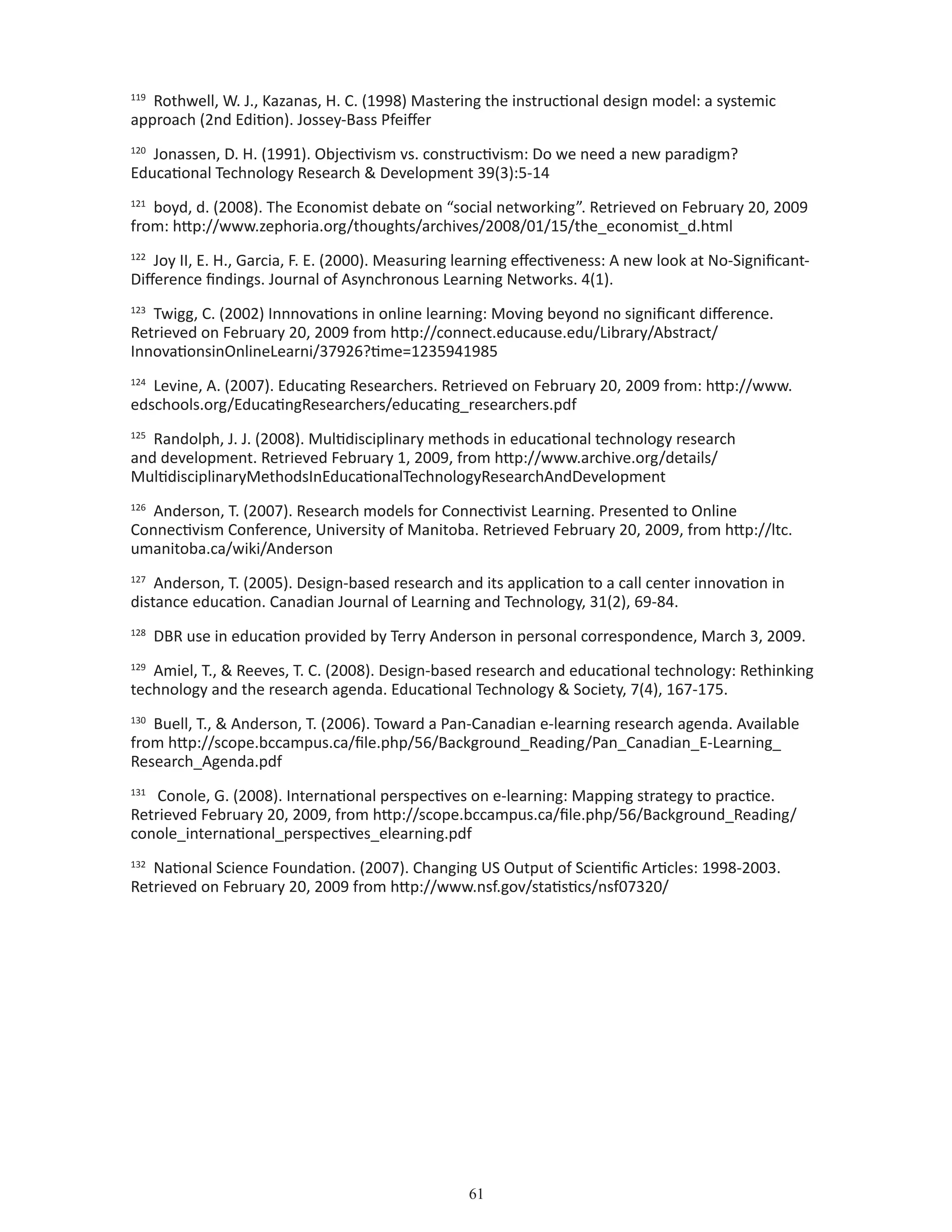This document provides an introduction to emerging technologies for learning by discussing major trends driving change in education, what is known about learning, and the role of technology in teaching and learning. It covers fragmentation of information, how learners now piece together content, and challenges for education in clarifying information. Research shows distance education can be as effective as face-to-face learning when pedagogical excellence is provided. The document aims to serve as a resource for educators on incorporating technologies into teaching.
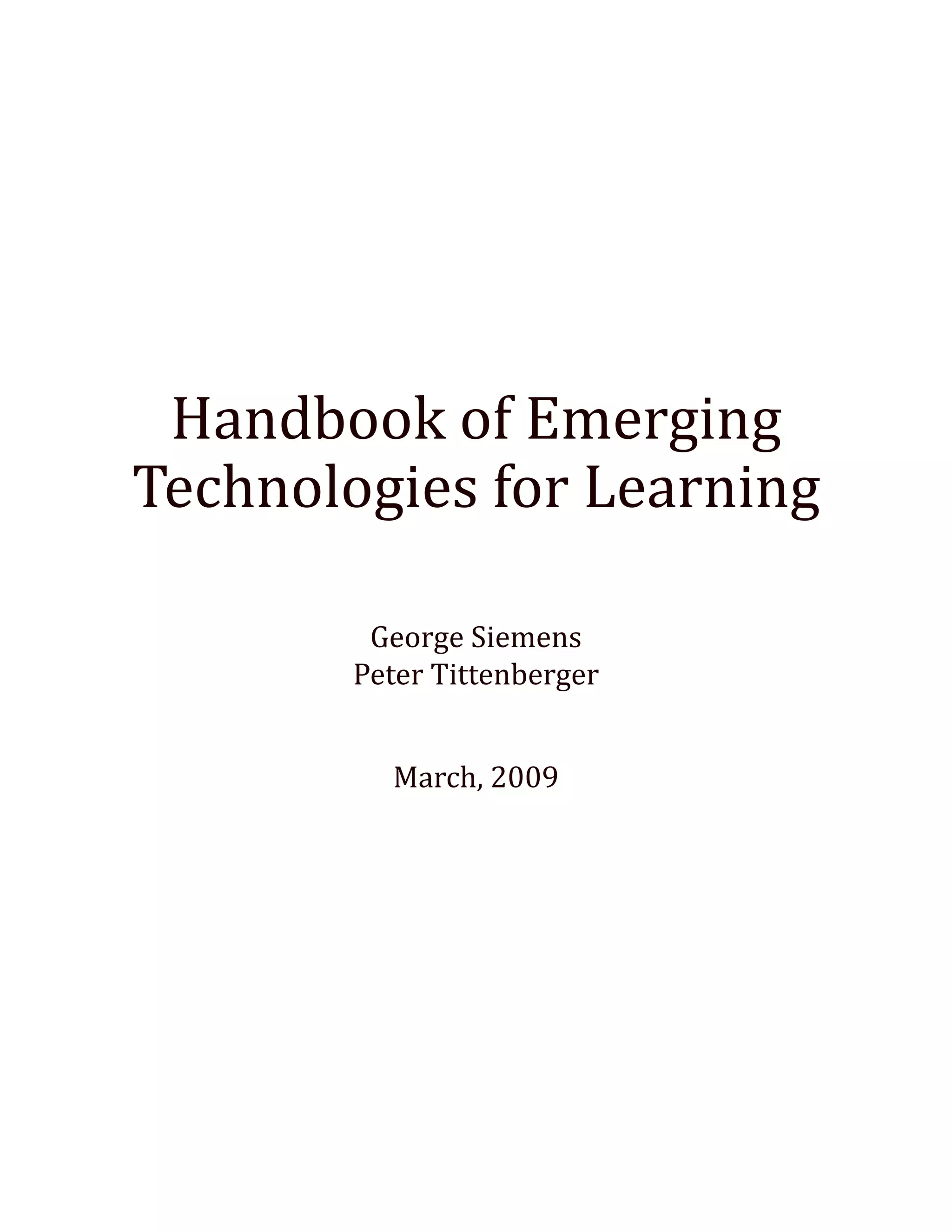

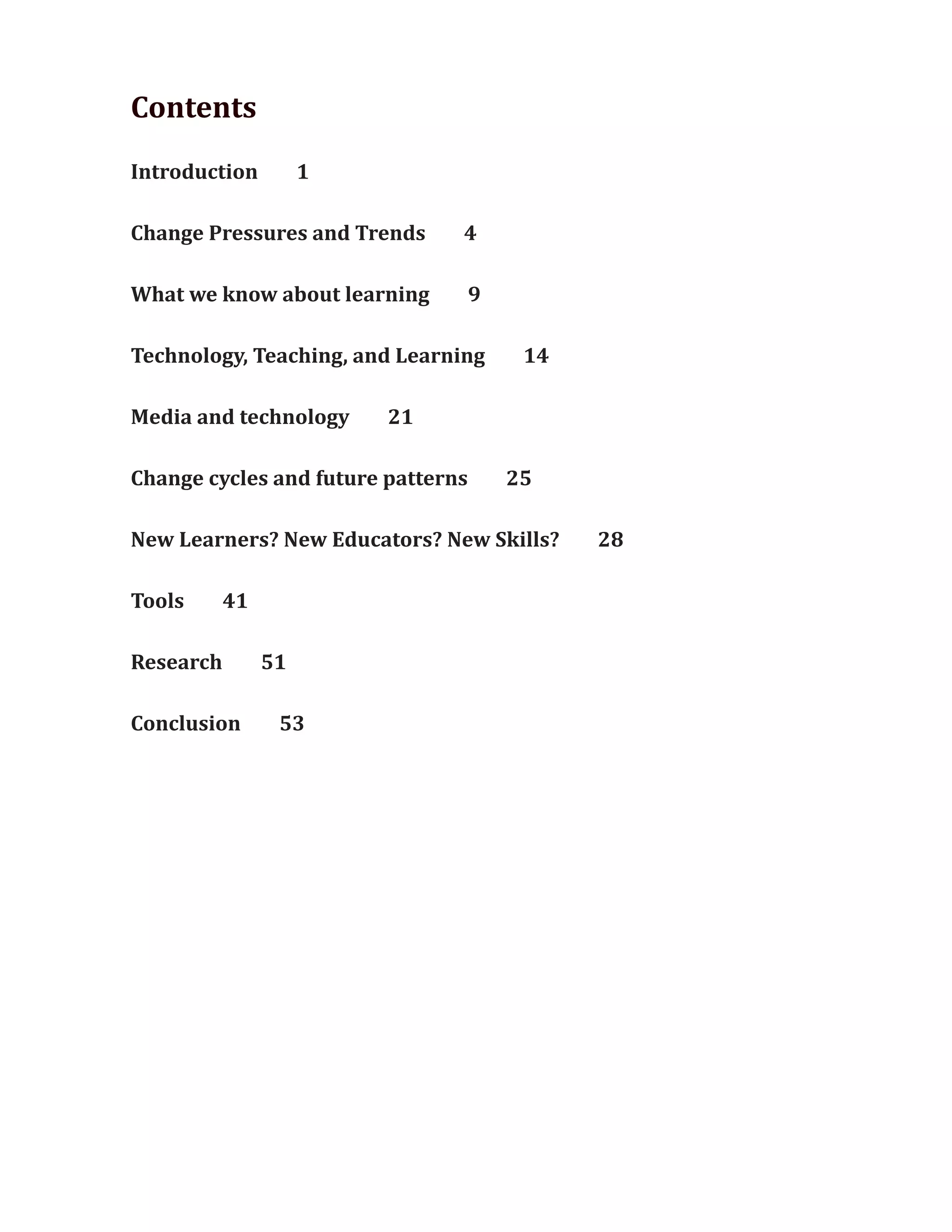
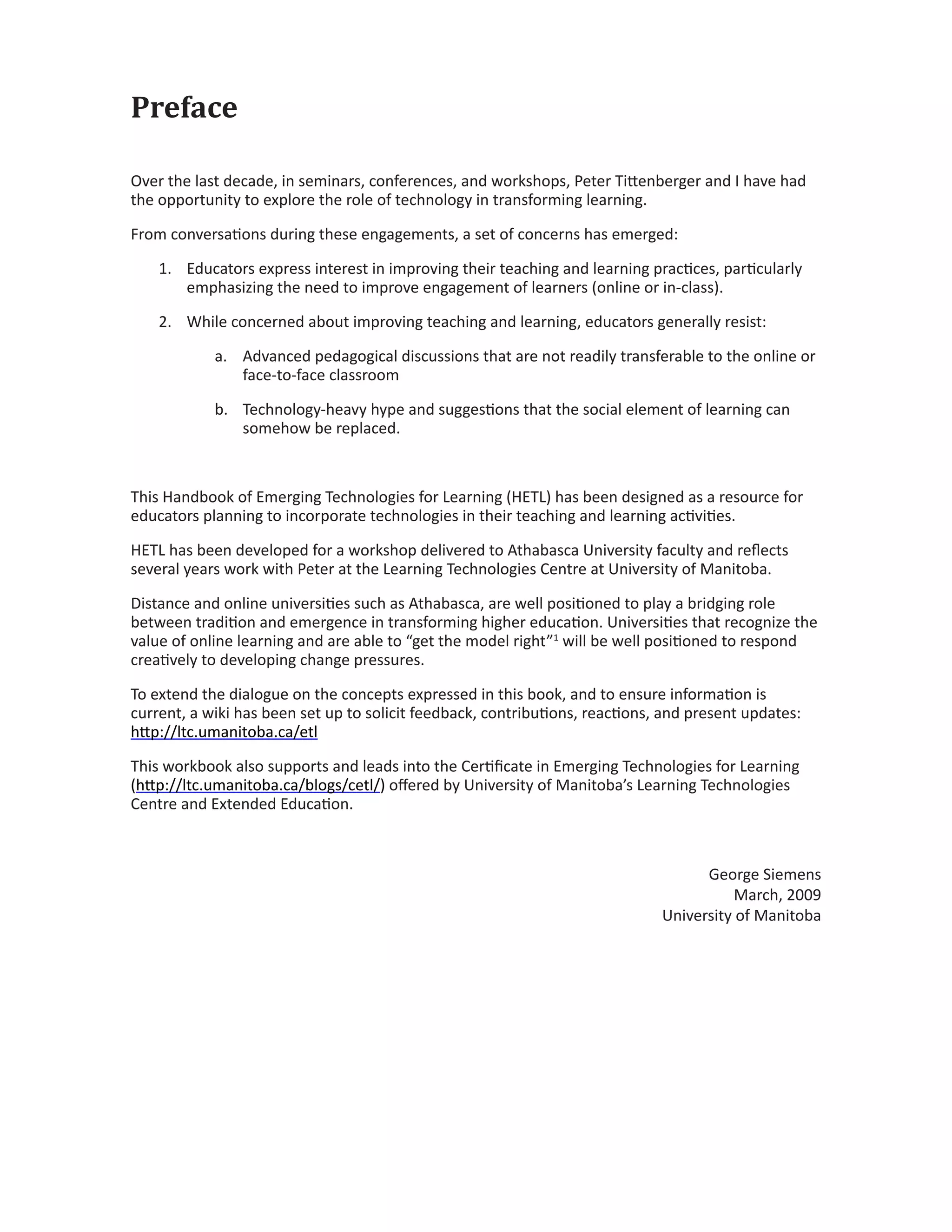
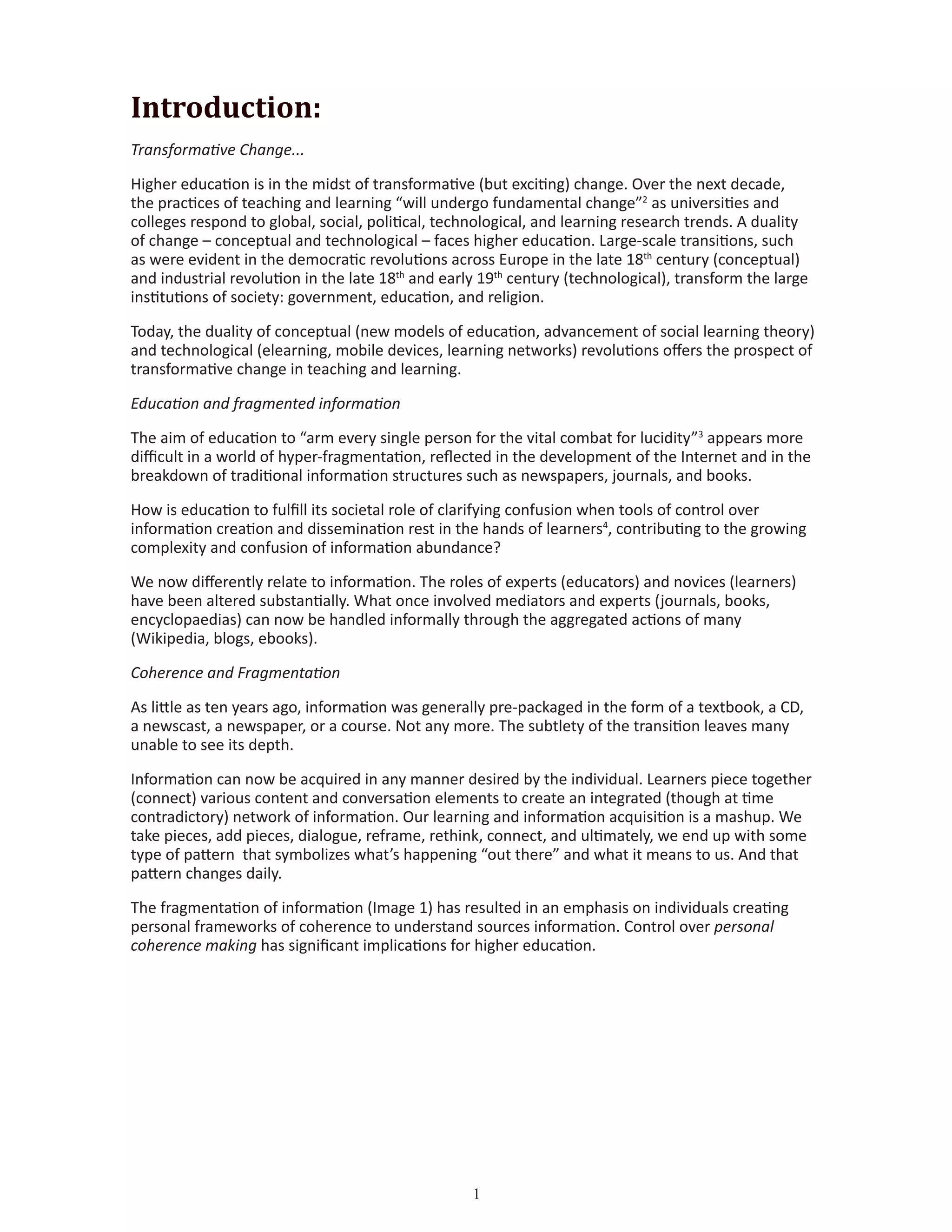
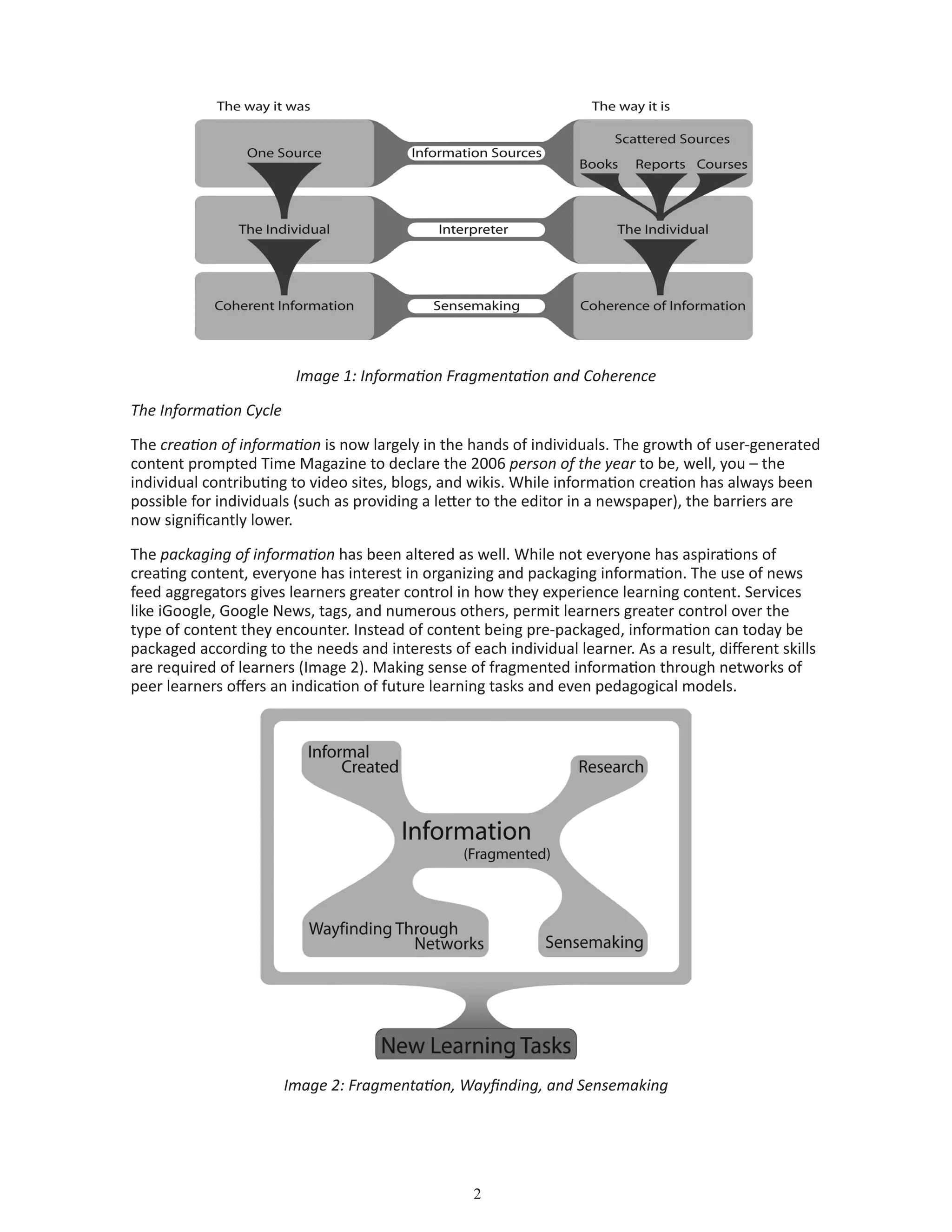
![The validation of information has also experienced change over the last decade. Wikipedia – an
online encyclopaedia where anyone can contribute – presents an alternative mode of information
validation (“the many”) from what is used in education (“the expert”). Instead of relying on experts,
Wikipedia (and sites like Digg) rely on the activity of many to discuss and validate information. The
aggregated actions of many, according to this view, are more effective than the actions of a few
privileged experts5
.
The dissemination of information still retains many of the attributes long valued in education: peer
review and critical discussion. Unfortunately, the long process of traditional scholarship is no longer
suitable when information is developing at an accelerated rate. Online journals (such as Innovate
and IRRODL) are helping to reduce the timelines of writing and publication. PLOS One has adopted
a peer review and annotation model after publication, not only prior to. New models of scholarship
will permit individuals a greater role in the formation of ideas, rather than only encountering the
ideas after publication6
. These alternative models of information dissemination place sustained
pressure on scholarship in higher education7
.
The sharing and publication of information is occurring at an unprecedented pace. Online journal
systems such as OJS, blogs and wikis, enable more rapid sharing of information and research than
higher education has encountered to date. The use of conferencing tools – Elluminate and Adobe
Connect – permit a more timely sharing of research.
The accreditation of the learner with regard to information has not experienced significant pressure
to date. While alternative models have been used (Microsoft and Oracle certification for example)
the model of accreditation in higher education remains firm. The advancements of “community-
validated experts” – such as eBay and Amazon - have not altered how competence is determined in
formal education.
Changes to the information cycle (from creation to validation) are at the core of change in higher
education.
Learners have increased educational opportunities due to the internet’s affordance of connectivity.
What once rested under the control of a privileged expert or organization is now under the control
of individuals. Even the organization, sequencing, and structuring of information is now largely
under the control of individual learners.
Content is generally viewed as something that learners need to cognitively consume in order to
learn. But learning is like opening a door, not filling a container. Content can be created through
the process of learning, not only in advance of learning. And increasingly, content co-creation and
re-creation (building on and using the content created by others to create something new) are
becoming the norm for online participants.
Is Technology Effective for Learning?
Research indicates that “effective [distance education] depends on the provision of pedagogical
excellence”8
and limited variability in results indicates “no significant difference” in Distance
Education (DE) and face-to-face learning (though calls have been made for greater variability
in research methods including discourse analysis and learner interviews)9
. Attitudes toward e-
learning, as “reflected by scholarly and academic reviews, range from neutral to positive”10
, indicate
DE courses offer similar effectiveness to traditional instructional approaches.
While learner control is desirable, “dramatic tension” (provided by course designers and
instructors) is required “in order to sustain a high level of participation”11
. Athabasca University
faces an additional challenge of keeping learners motivated and engaged while permitting them the
freedom to progress at their own pace, often in isolation from, and absence of social interaction
with, peers.
Unfortunately, in many universities “web technology...[is]...primarily used for support of logistical
processes rather than for pedagogical change”12](https://image.slidesharecdn.com/178936784-handbook-of-emerging-technologies-for-learning-150926161322-lva1-app6892/75/Siemens-handbook-of-emerging-technologies-for-learning-7-2048.jpg)

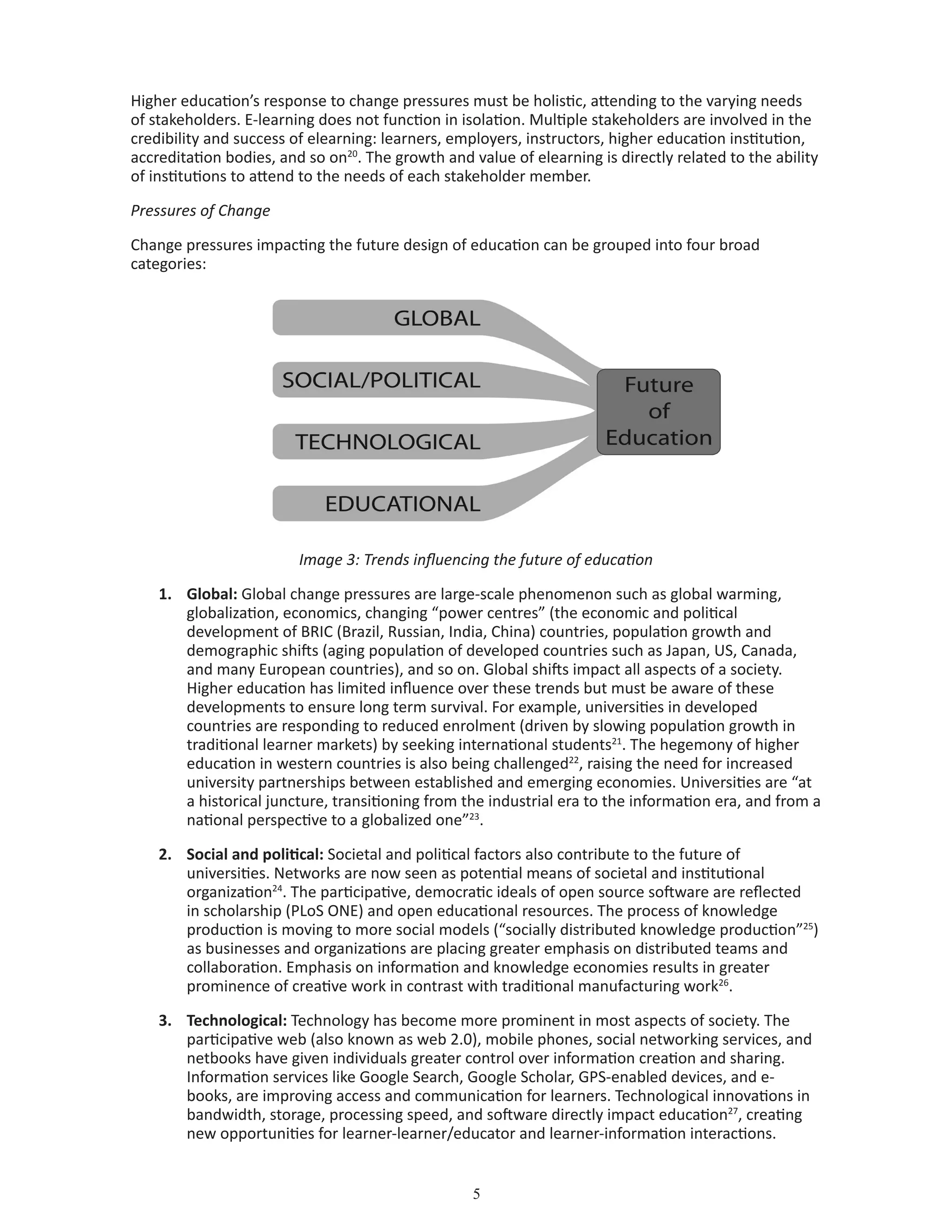
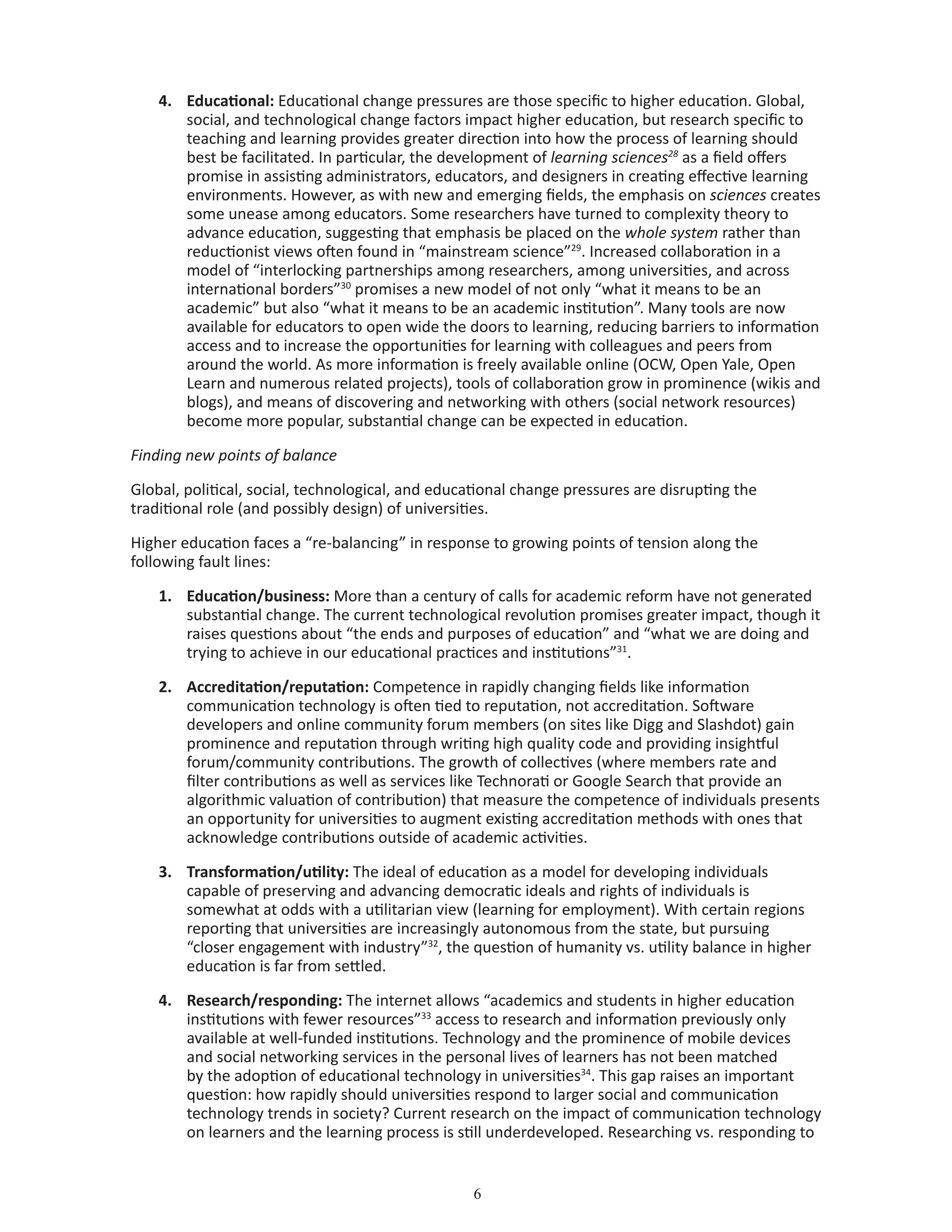
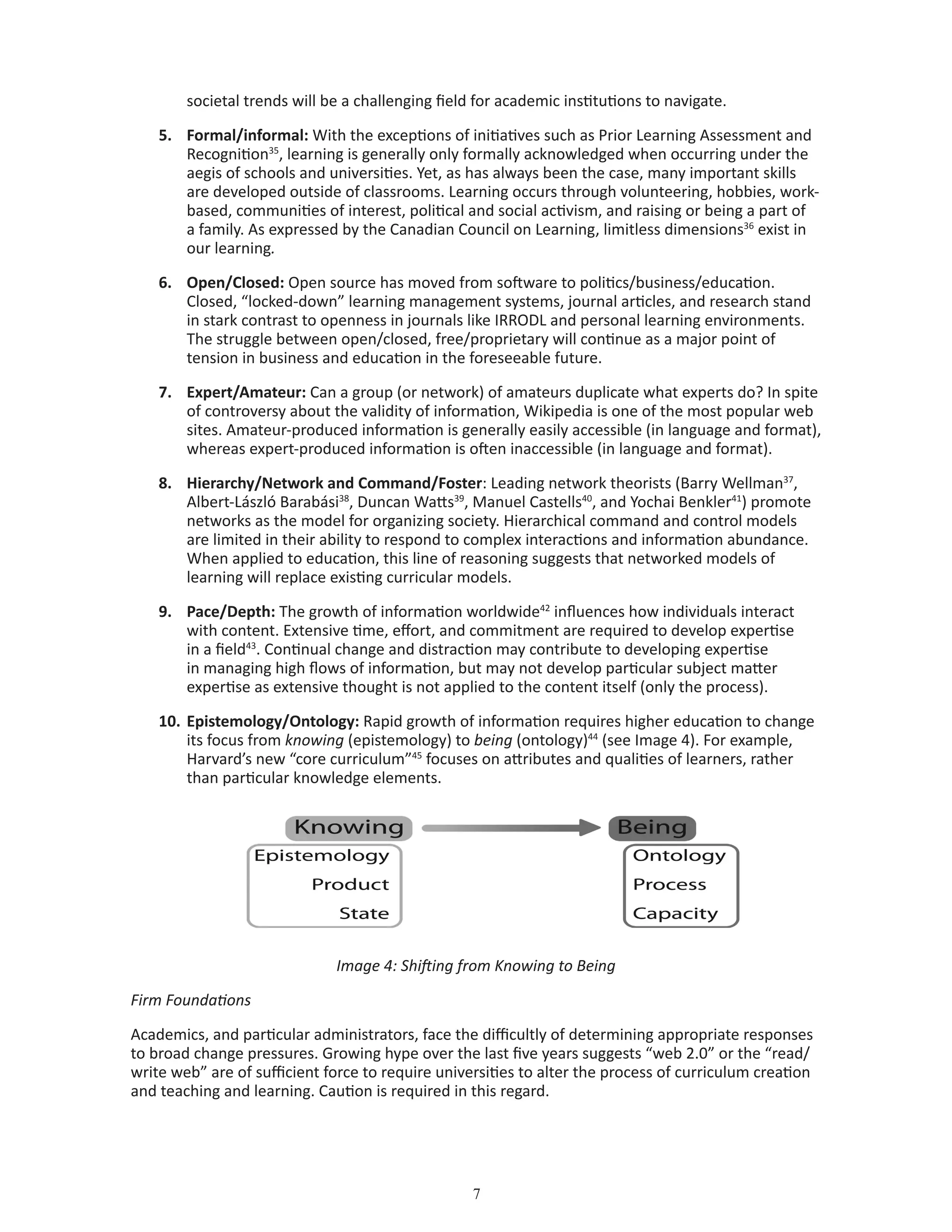
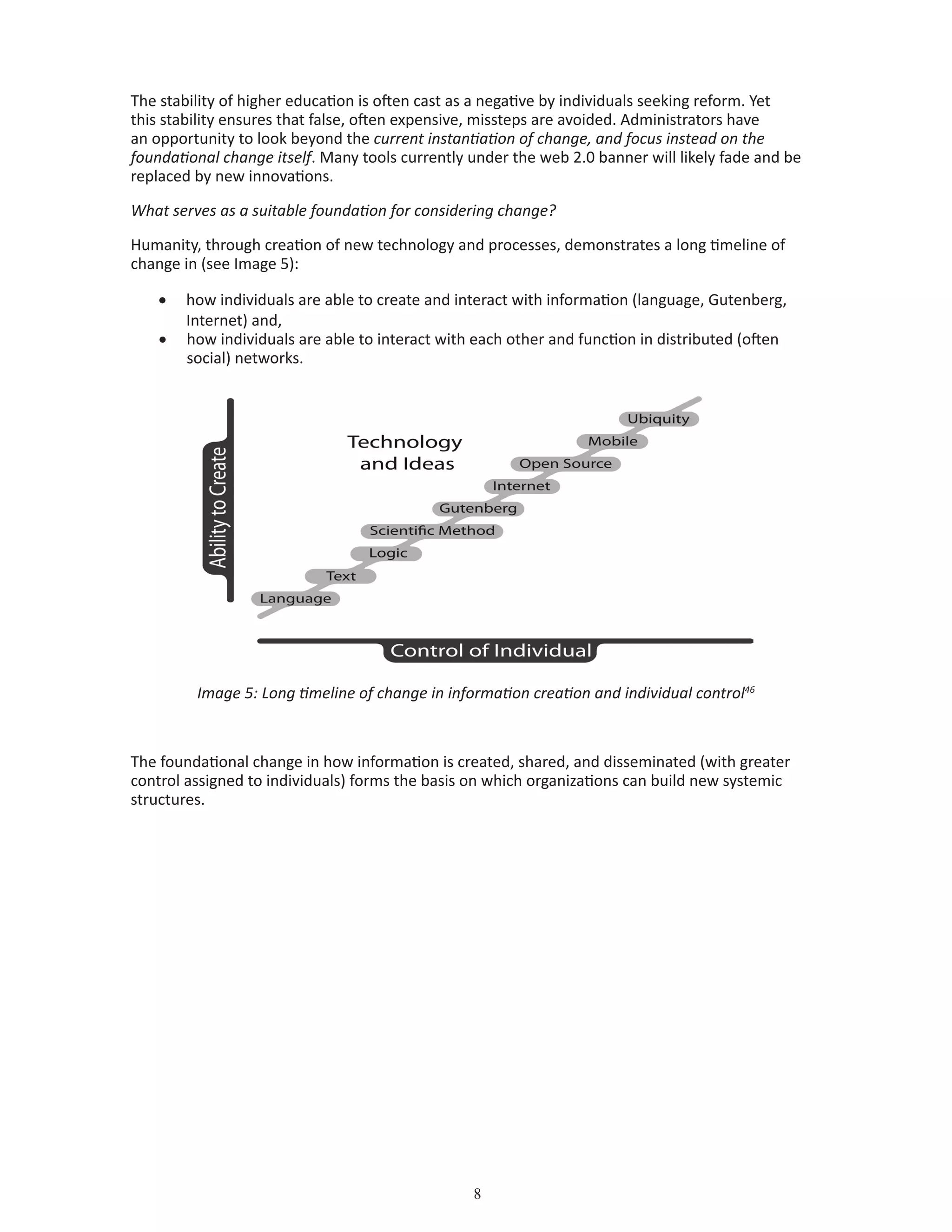
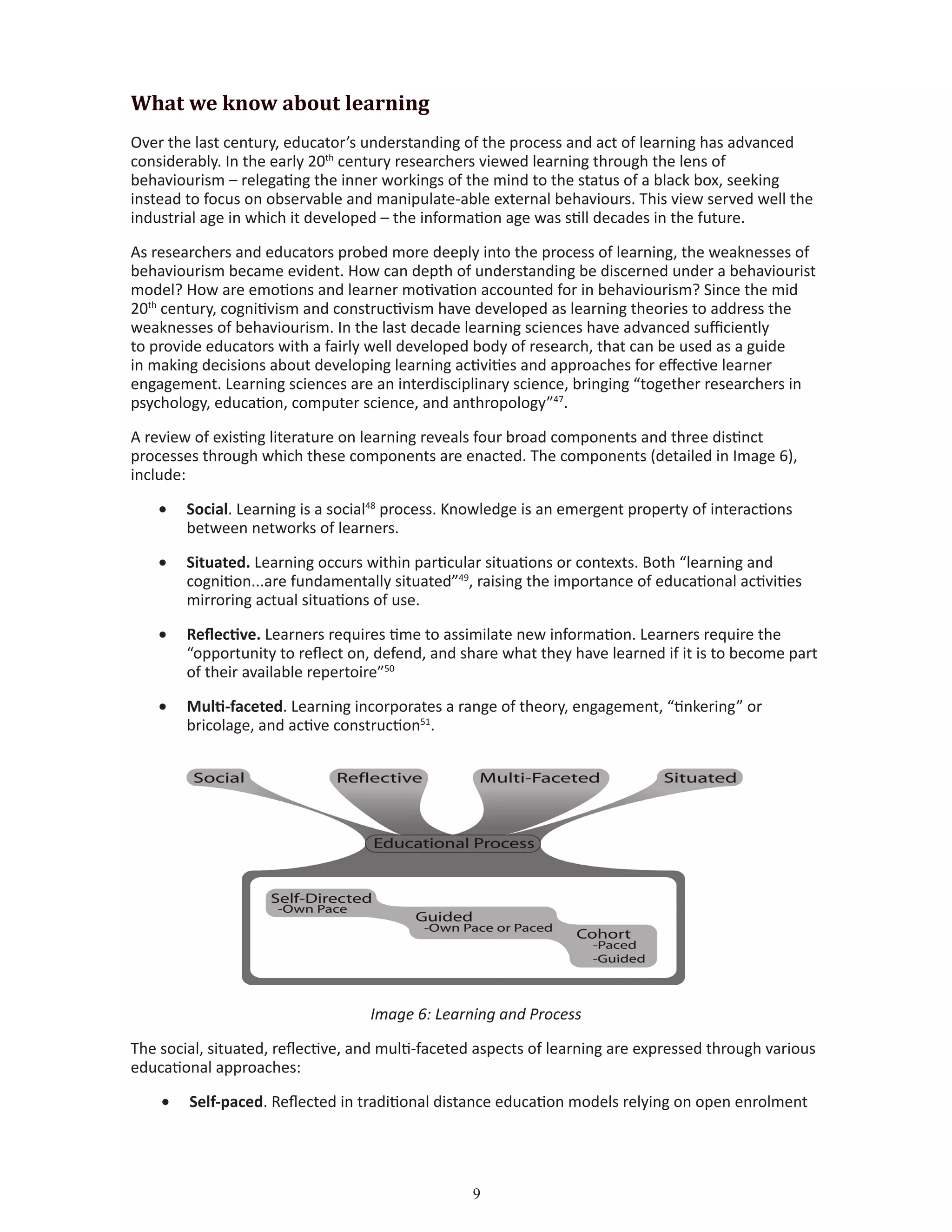

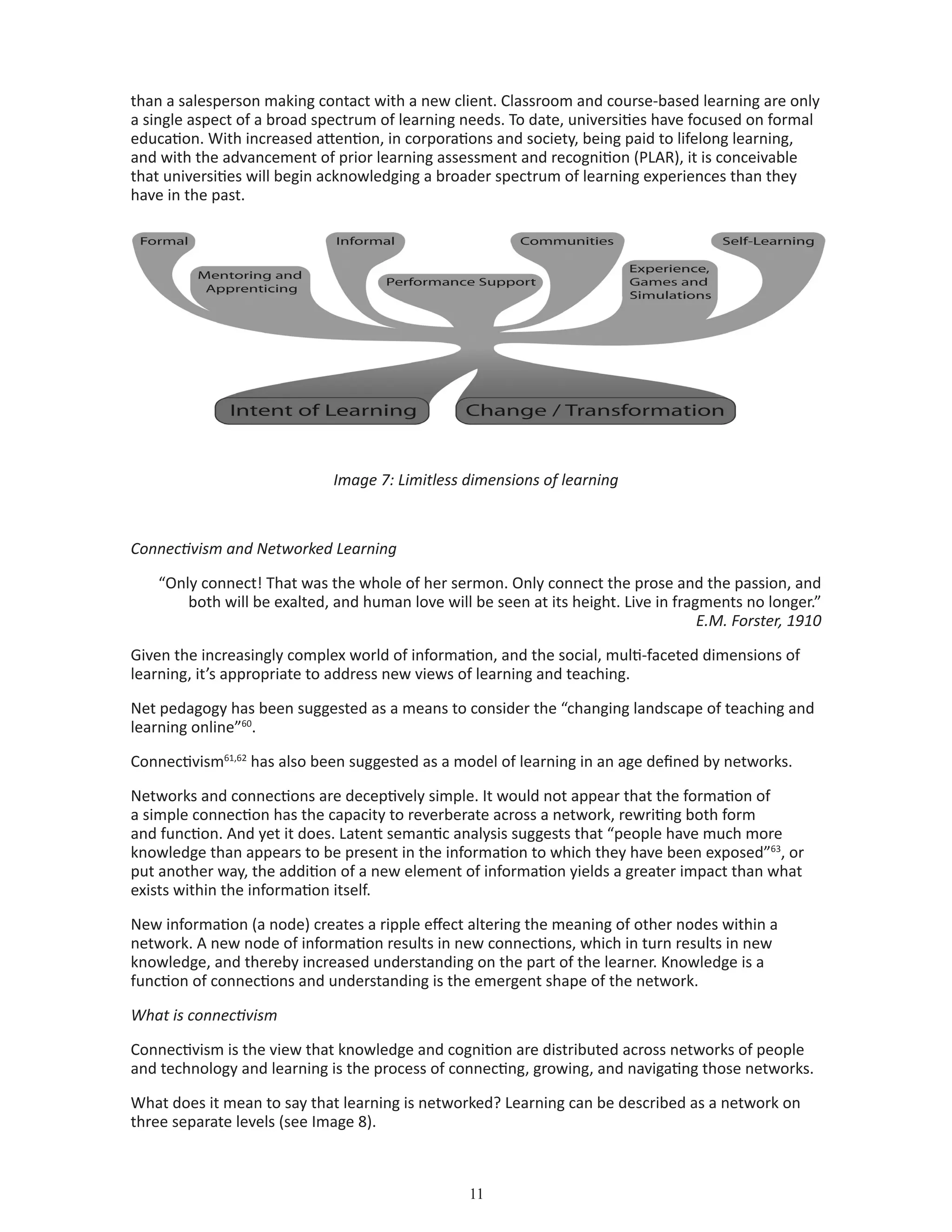
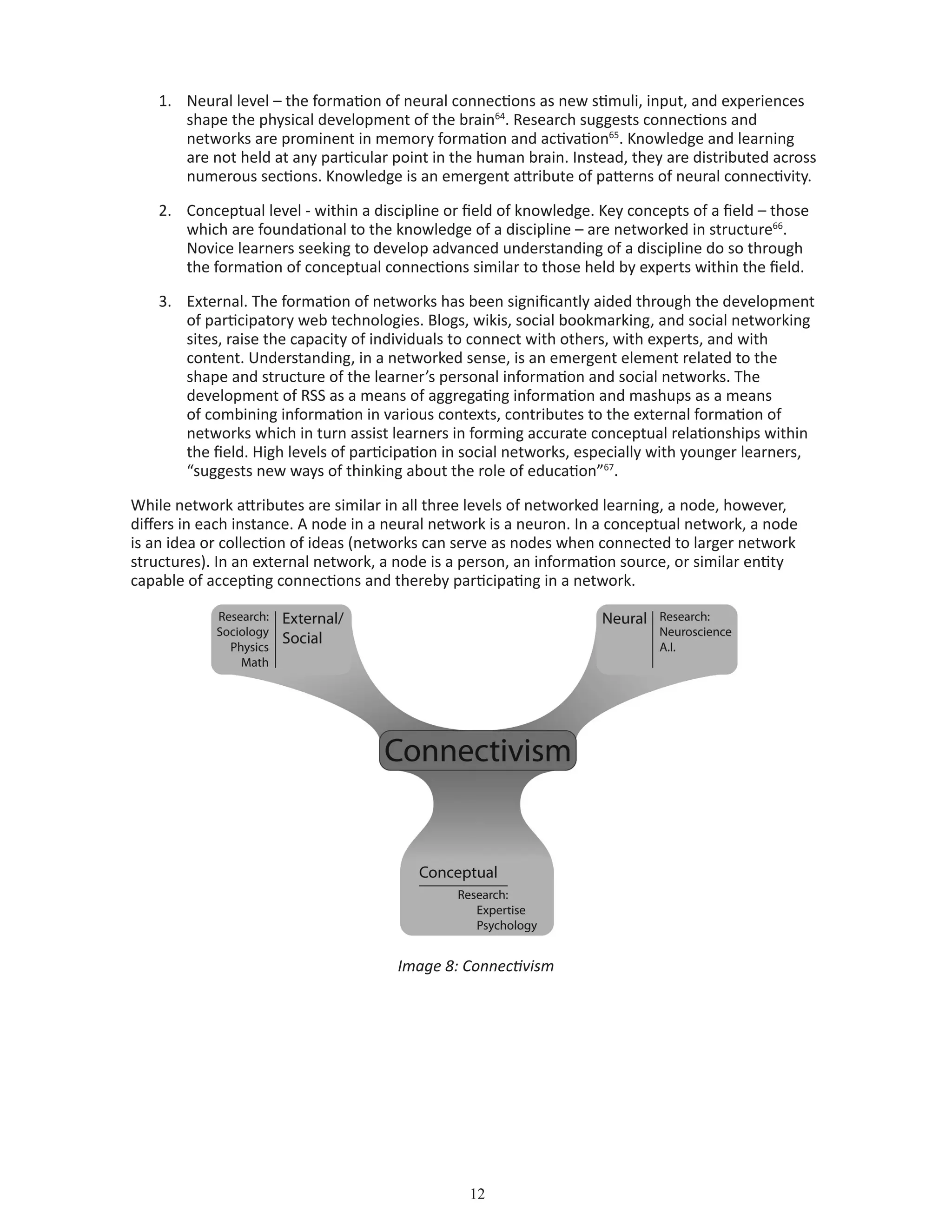
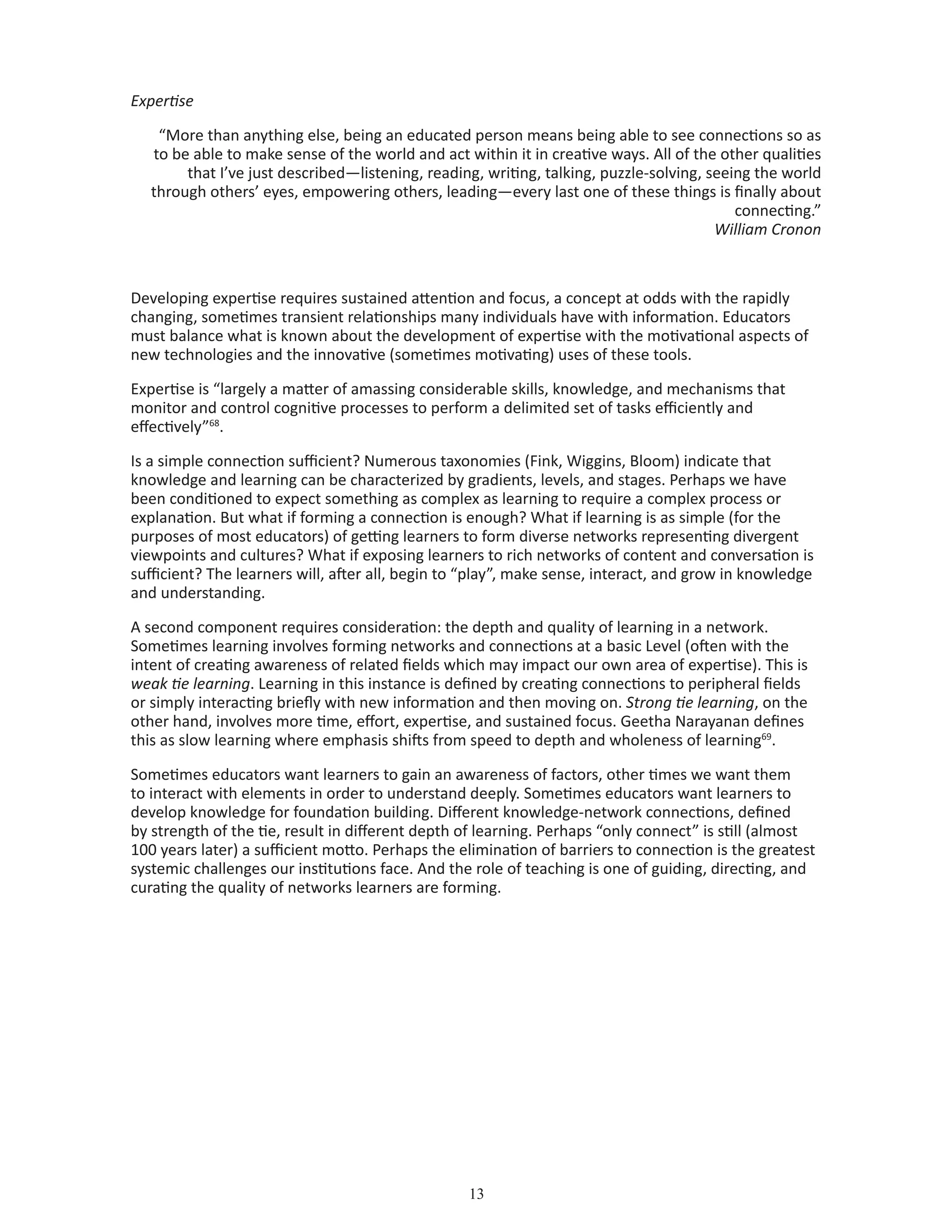
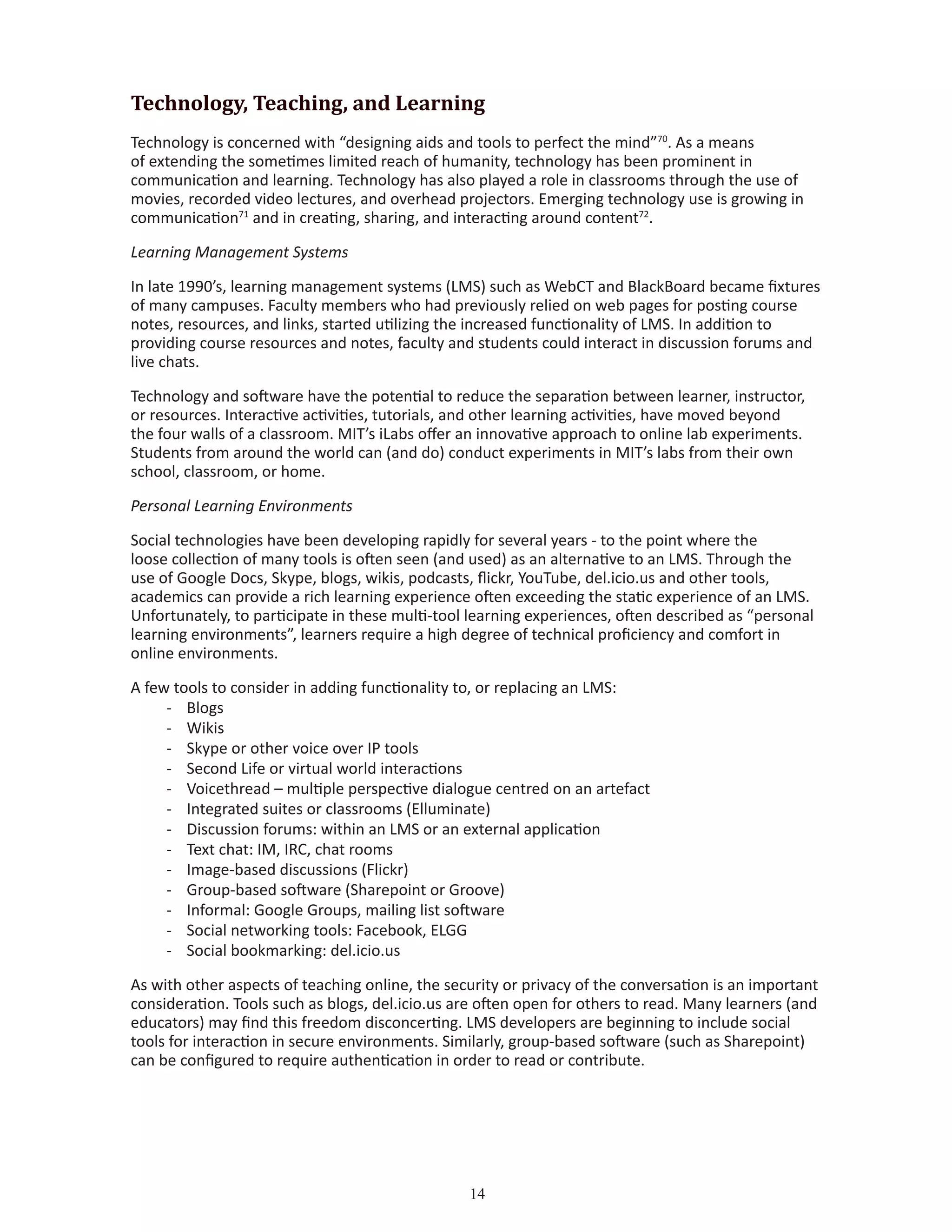

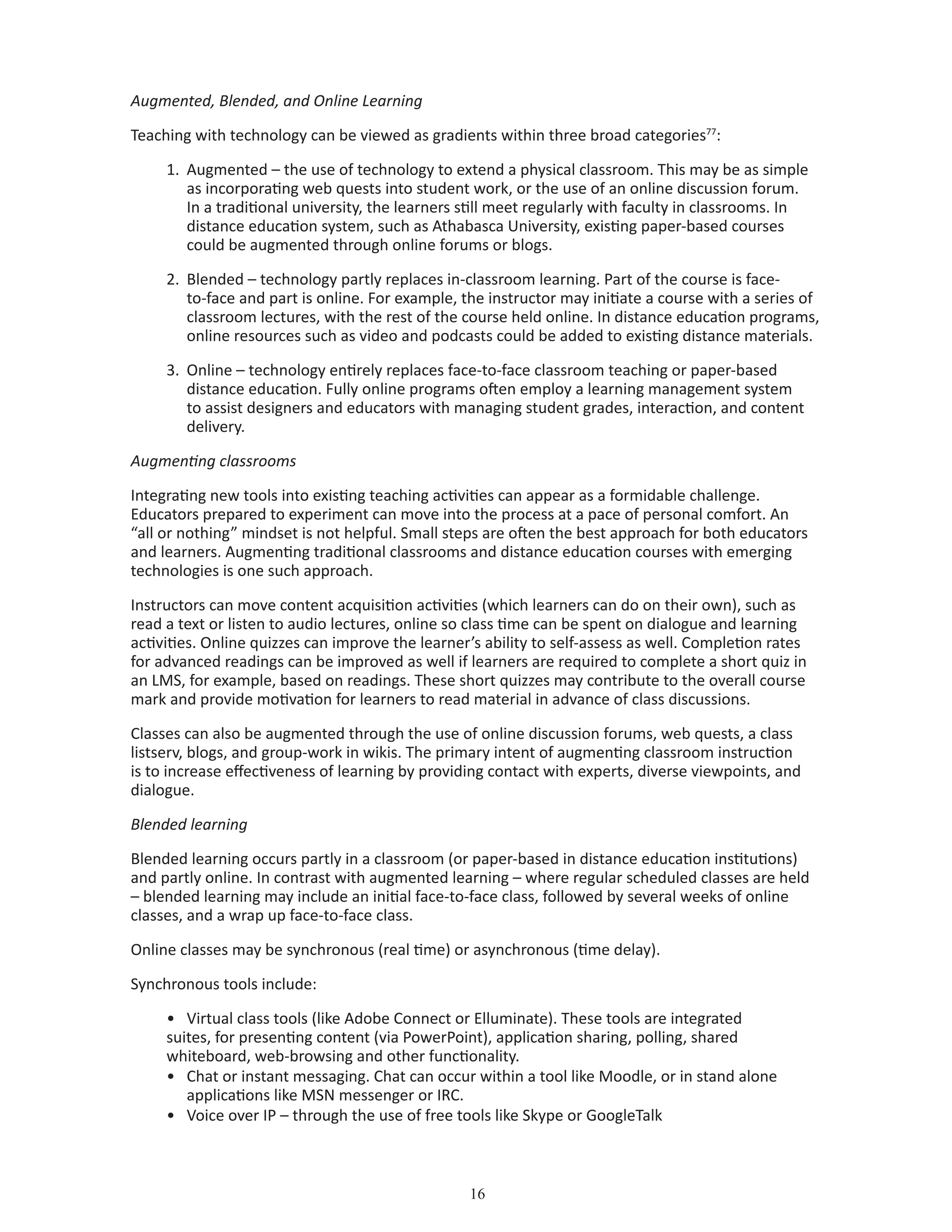
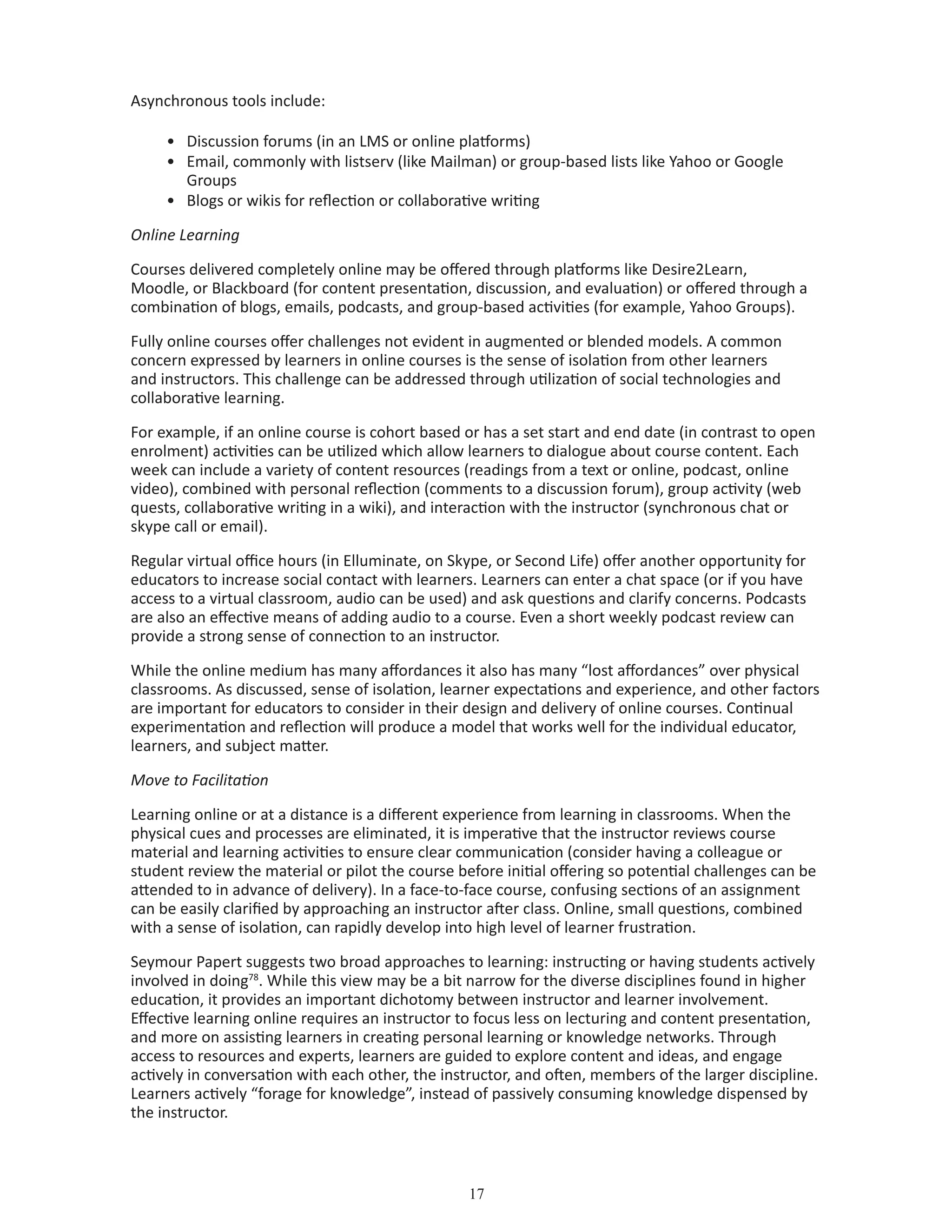
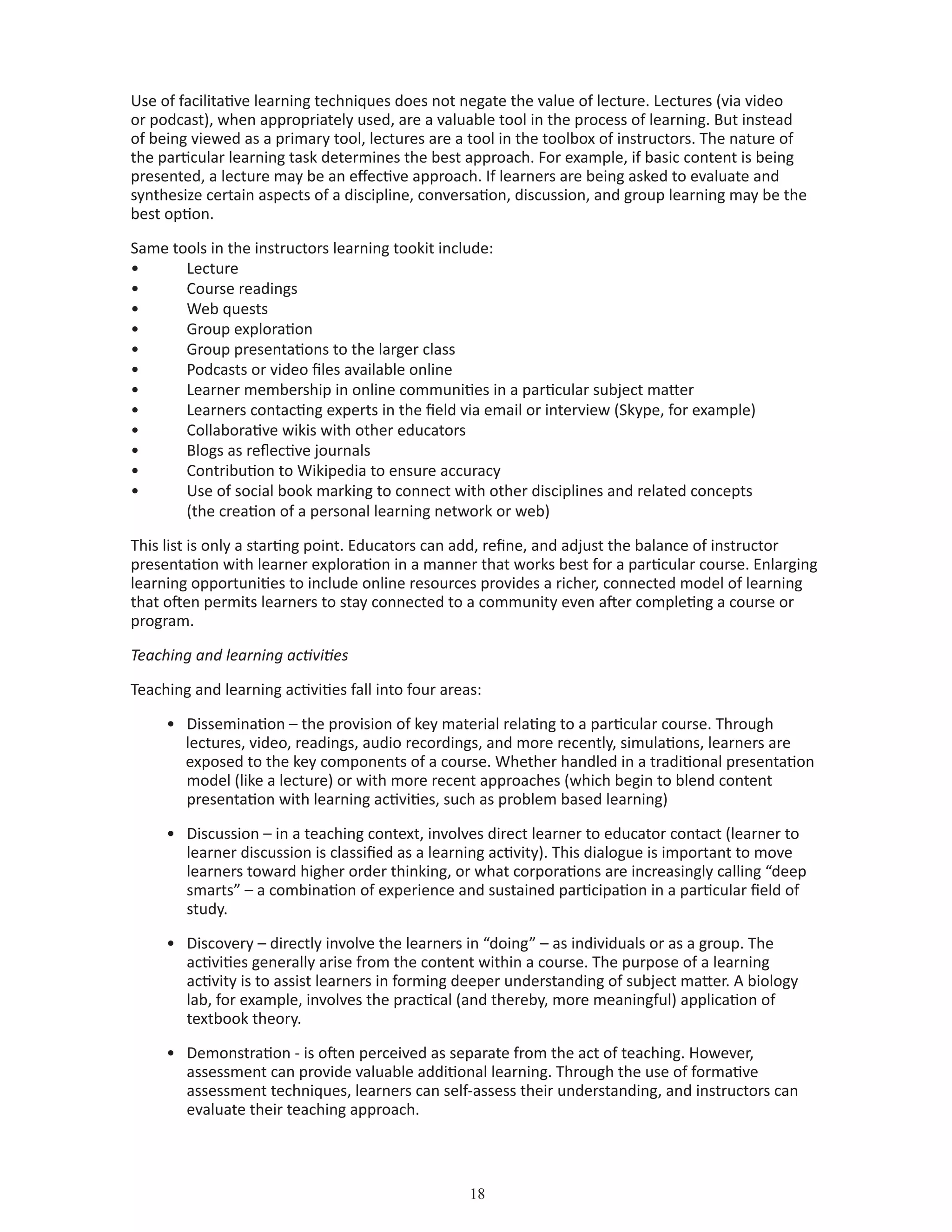
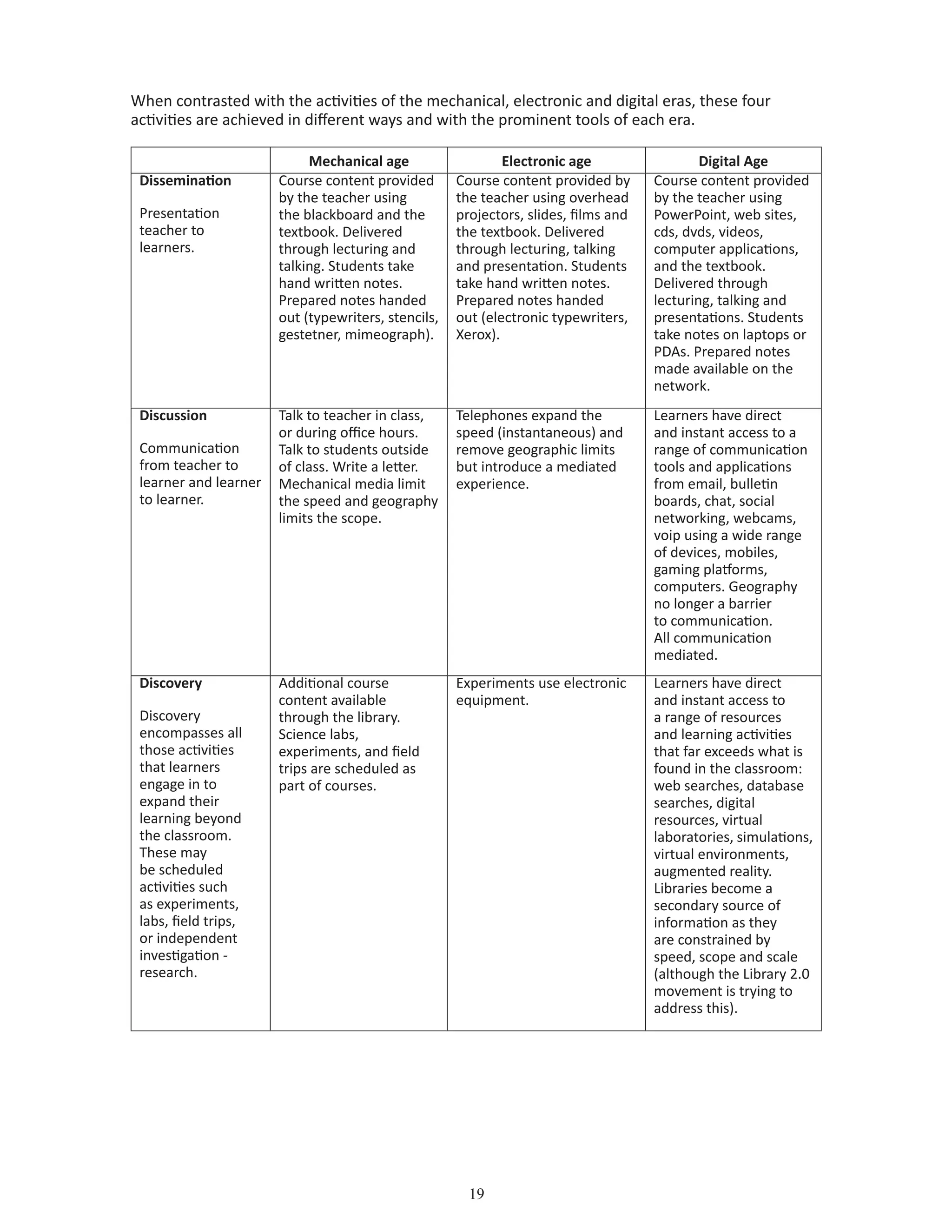
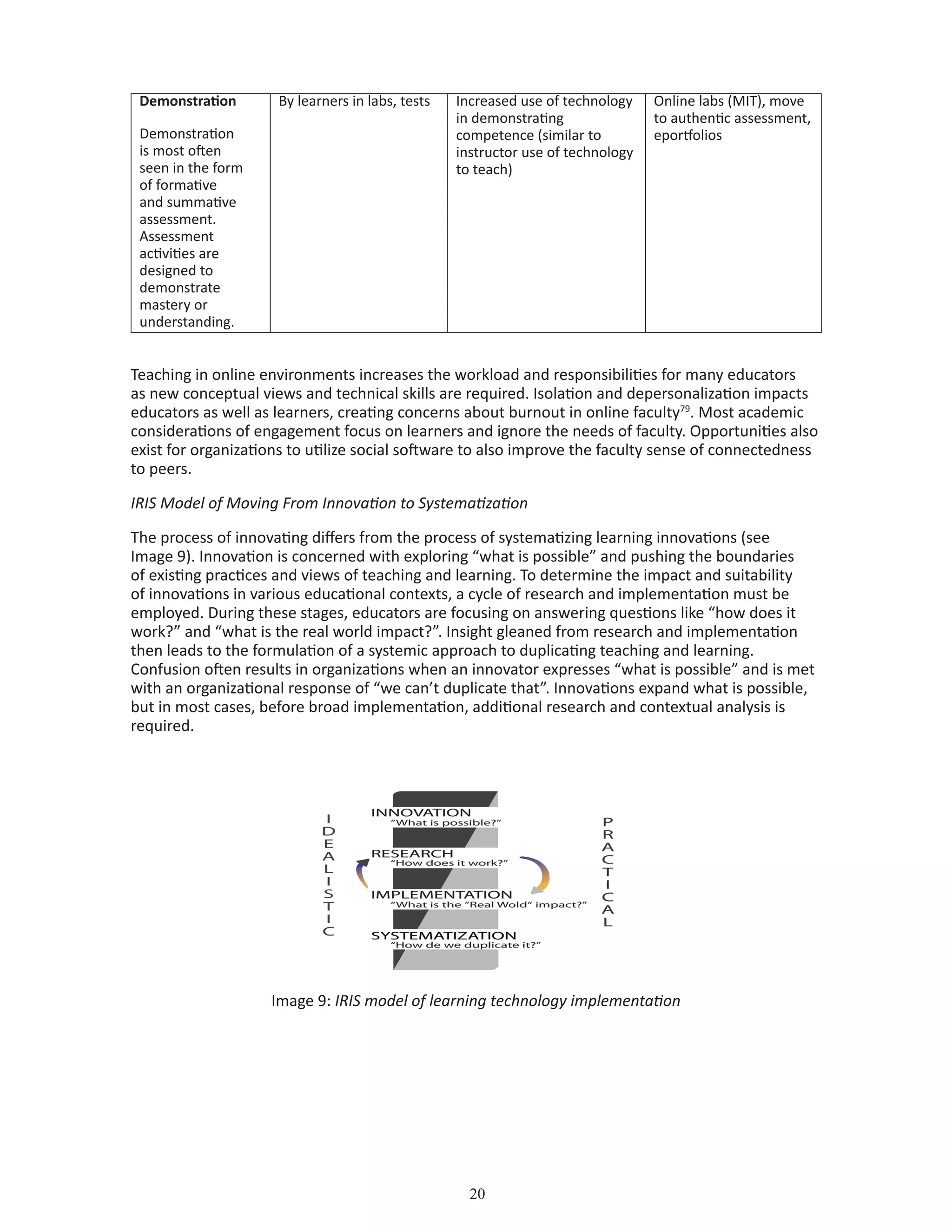

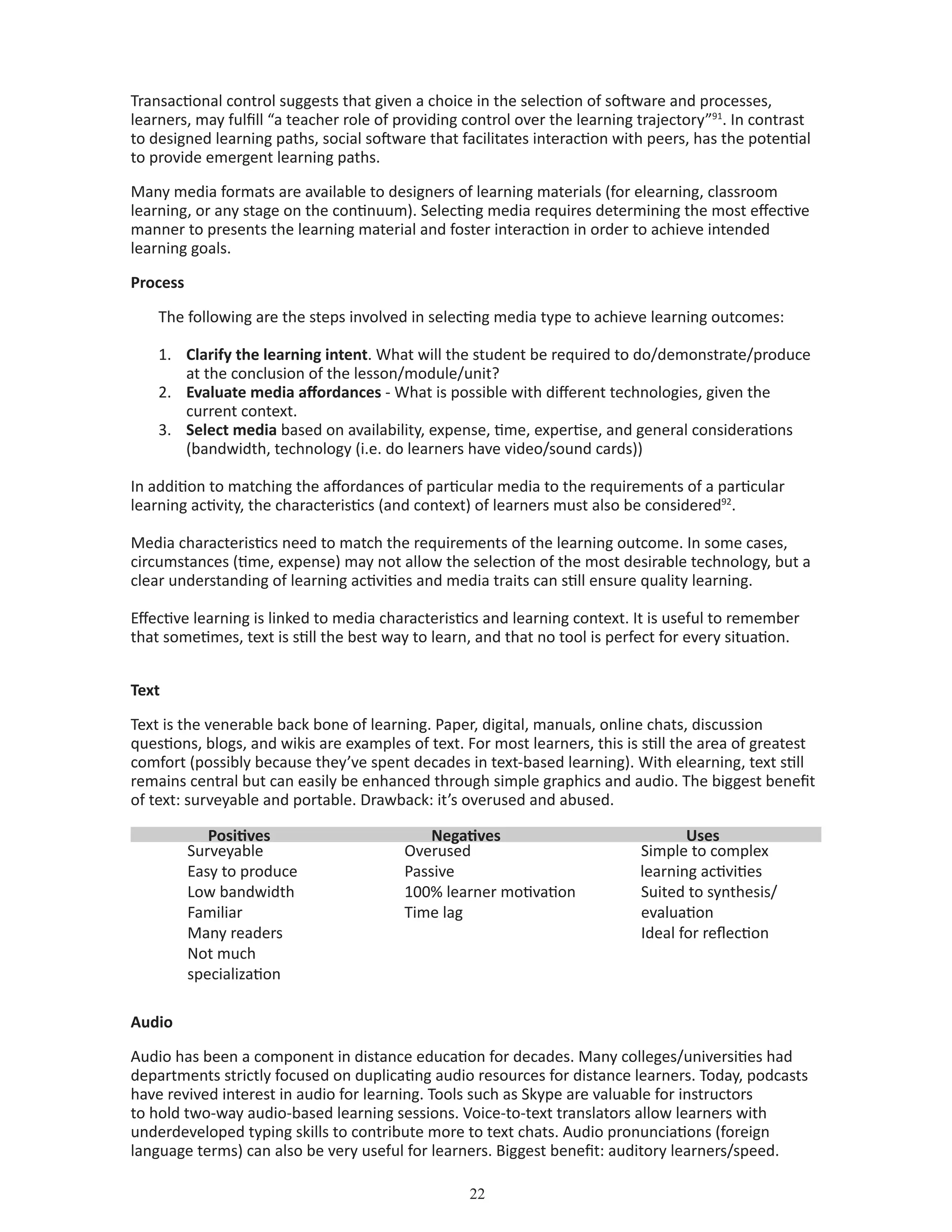
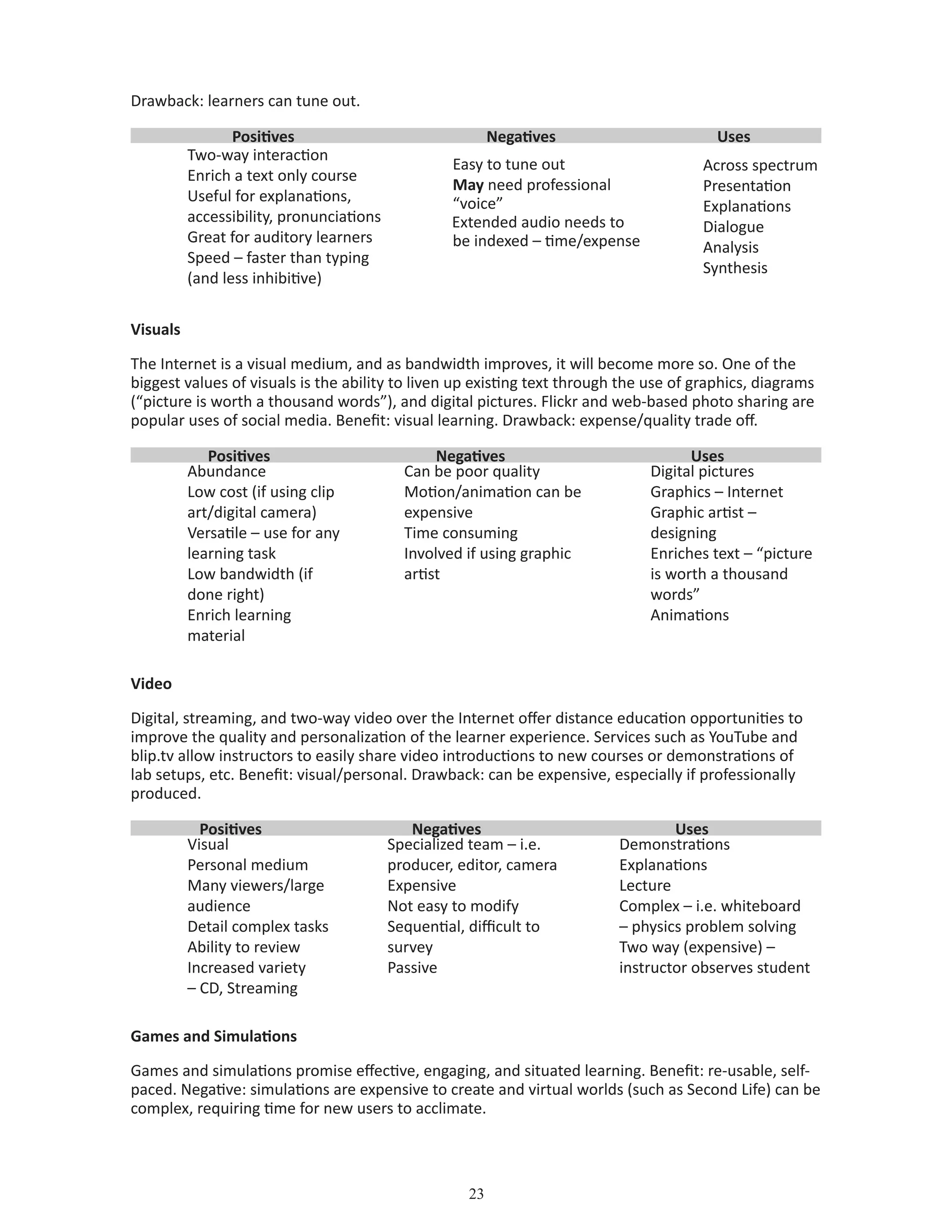

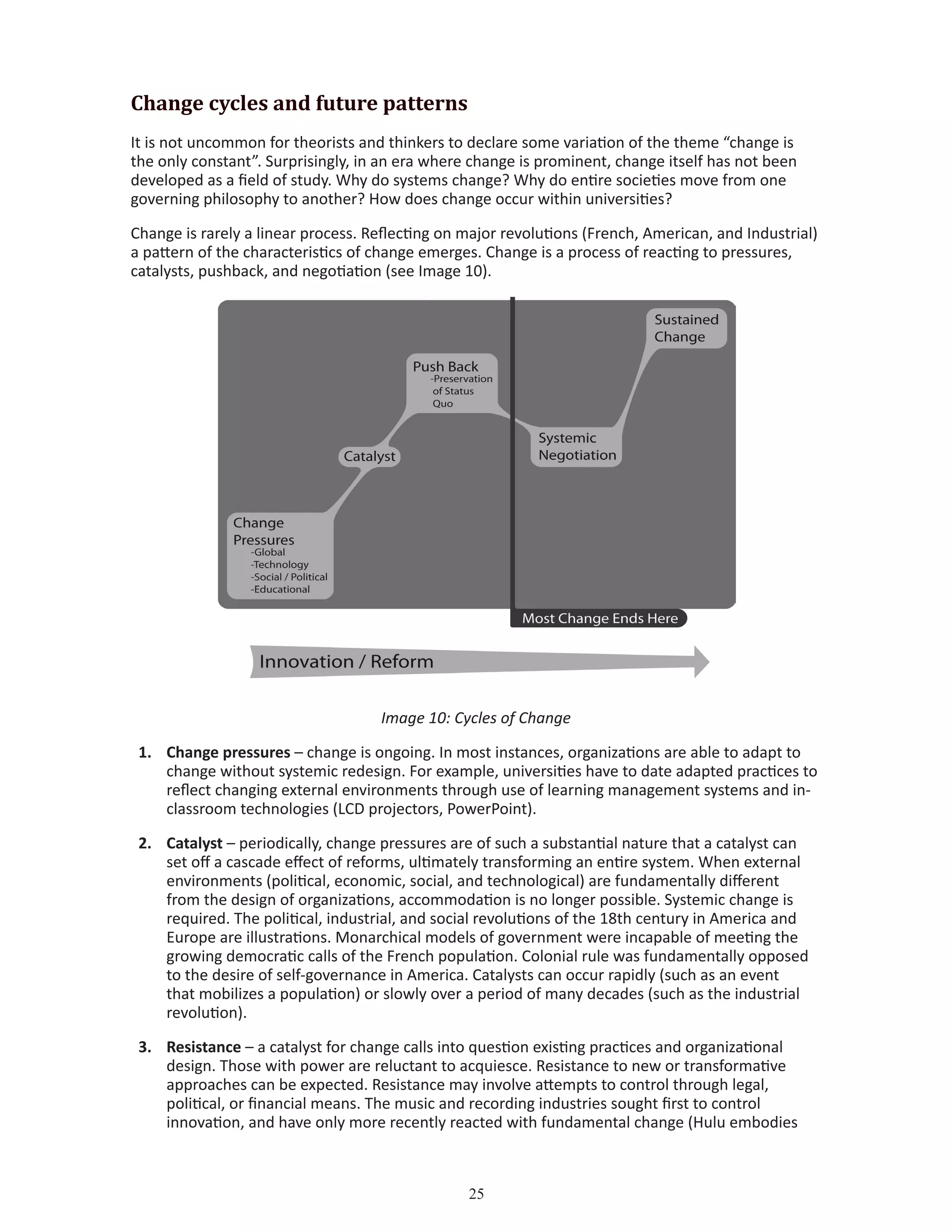
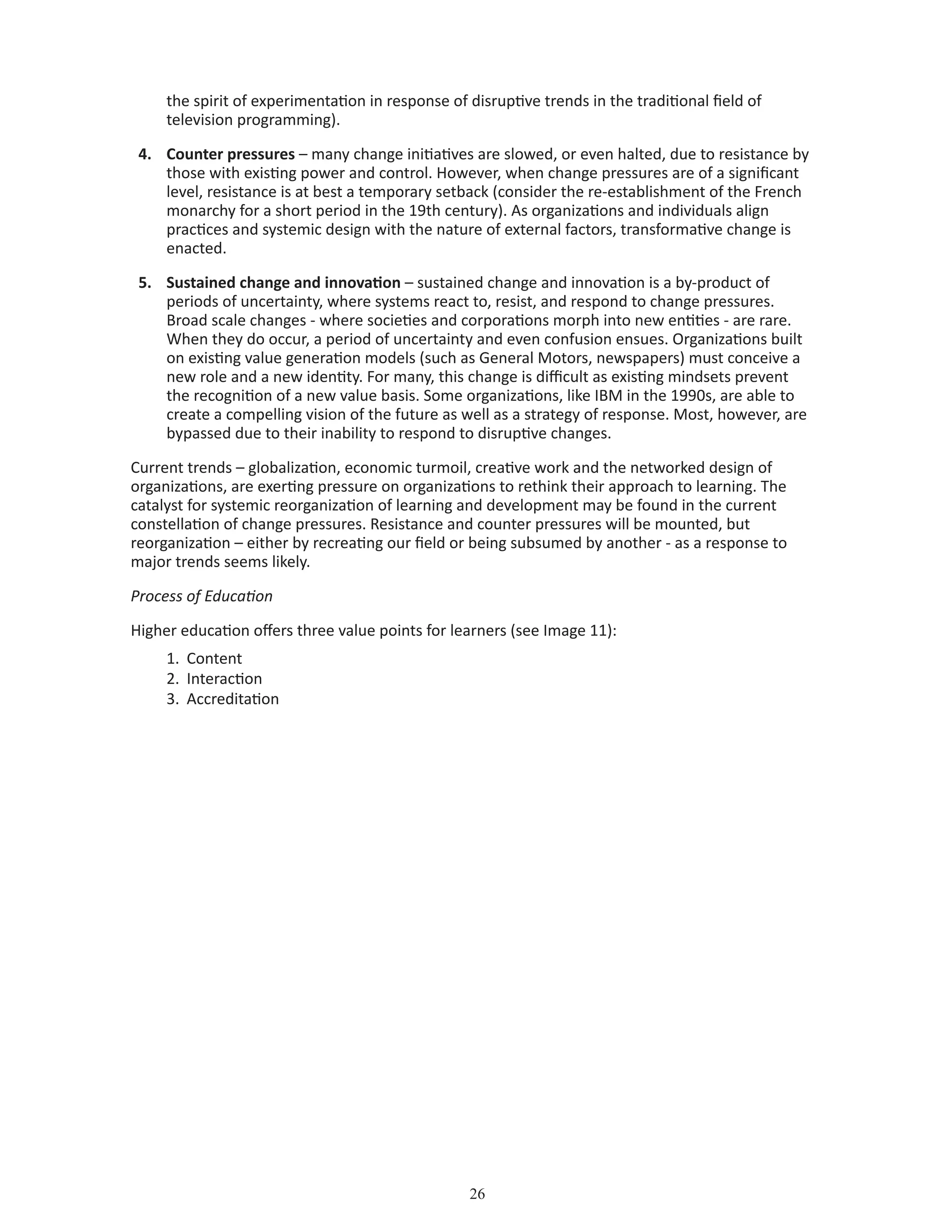
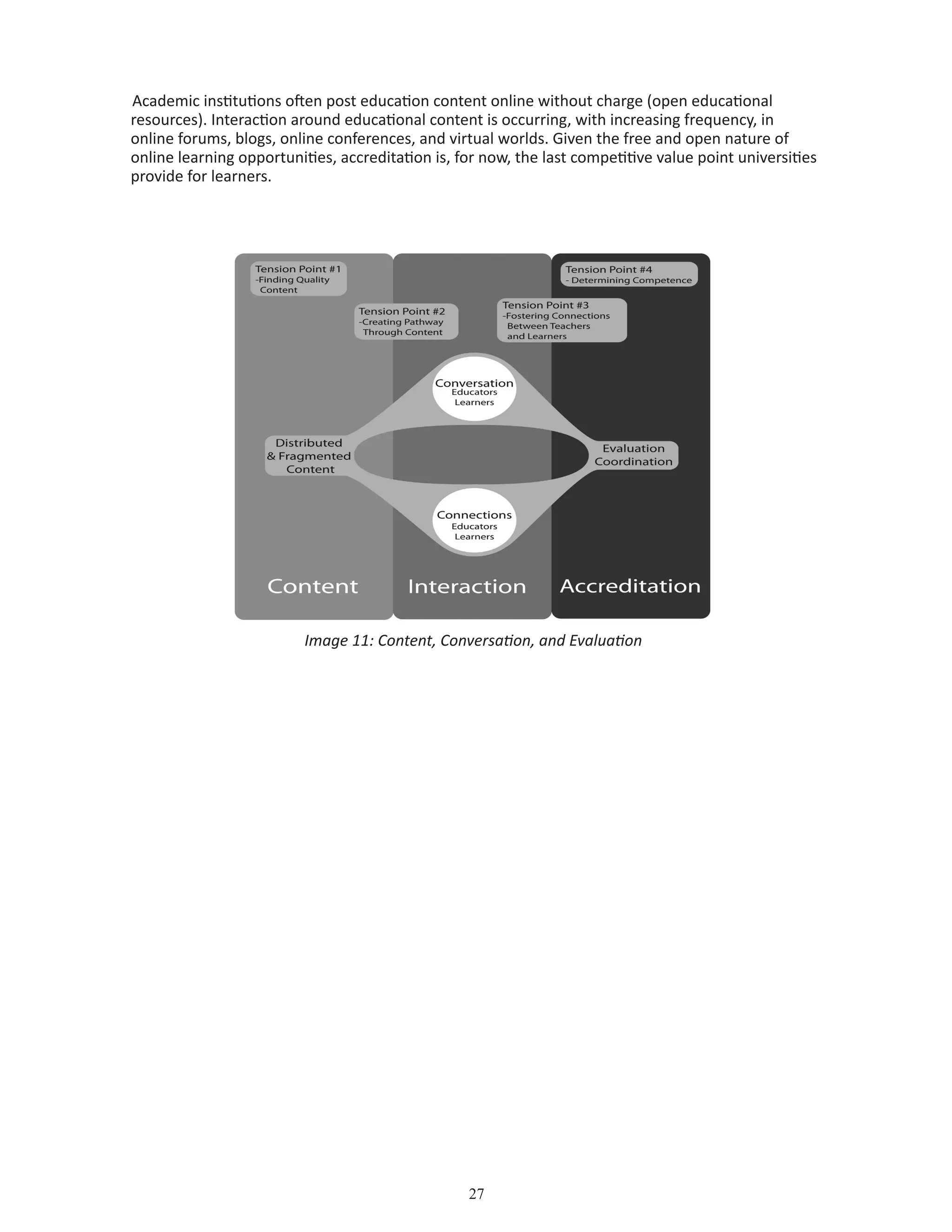
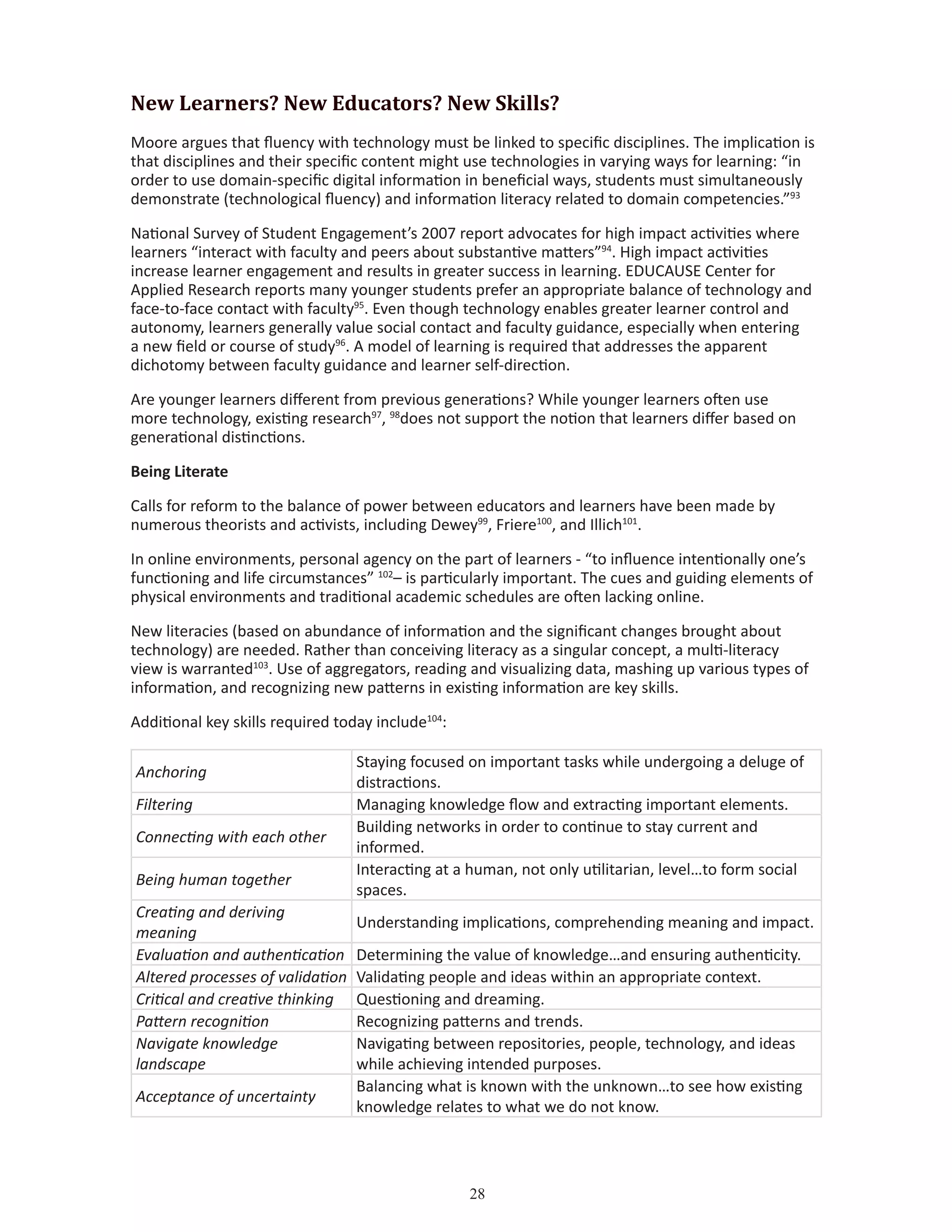
![29
Contextualizing
(understanding context
games)
Understanding the prominence of context…seeing continuums…
ensuring key contextual issues are not overlooked in context-
games.
Minimal or guided learning?
Kirschner, Sweller Clark question the tenets of problem-based learning105
, highlighting the
unsettledness of the debate between instructor or learner control in learning activities. They argue
that the constructivist views of learning are accurate, but the “instructional approaches suggested
by constructivists” are not necessarily effective. Of particular concern for the authors of the paper
is the degree of instructor (or expert) presence during the learning process. They assert that
minimal guidance is not as effective as guided instruction due to different approaches evident in
how experts function (epistemology) in a domain and how learners best learn.
Gardner states that the distinction between an expert and novice is found in the how information
and ideas are related to each other: “But shorn of their connections to one another, to
underlying ideas, to a disciplined way of construing this pile of information, facts are simply “inert
knowledge””106
. The conceptual network of an expert is more richly connected, nuanced, and
diverse than that of a novice.
In contrast with strong guidance, Sugata Mitra details an experiment he conducted in India (now
commonly known as the “hole-in-the-wall” experiment) where he placed a computer with an
Internet connection in a wall facing a ghetto107
. Within days children aged 6-12, with minimal
education and limited understanding of English, were able to browse the web and perform
other tasks – such as drawing - on the computer. The self-taught, minimally-guided nature of the
experiment led Mitra to the conclusion that children do not require direct instruction to acquire
basic computer literacy skills.
Research by Darken and Sibert on “wayfinding”108
explores a similar theme of the learner-in-
control approach to learning; how participants in large virtual worlds orient themselves in their
environments in order to achieve certain tasks or arrive at certain locations. With wayfinding, the
effectiveness in achieving objectives for learners/participants is determined by the design and
incorporation of environmental cues. Whether self-directed and initiated (Mitra’s research) or
aided through advance consideration of design (Darken and Sibert), it is clear that many learning
objectives can be achieved without direct guidance.
The concern of minimal guidance in learning is compounded by the growth of online content
created by amateurs. The criticisms levelled at knowledge sources created by the self-organizing
“masses” are often applied to the concept of learner-directed activity. Two significant challenges
arise when considering learning as being largely under the control of learners themselves. The first
is generally found in some variation of “how will the learners know what they need to know?”.
The second relates to the rapid decentralization and distribution of most of societies channels of
communication - newspapers, television, radio, and, more recently, academic publishing – and
raises concerns of how learners are to make sense of information in a field that is fragmented and
distributed, rather than well organized and coherent (such as information found in a traditional
textbook).
Personal learning environments (PLEs) offer a future model of learning that incorporates a greater
range of tools, largely under the control of the individual. PLEs are “not a piece of software...[but]
an environment where people and tools and communities and resources interact in a very loose
kind of way”109
.
The Role of Educators in a Networked World
The role of the educator and the process of instruction have been under pressure to change for
over a century110
. While camps, as discussed, often fall into conflict on principles of minimal or](https://image.slidesharecdn.com/178936784-handbook-of-emerging-technologies-for-learning-150926161322-lva1-app6892/75/Siemens-handbook-of-emerging-technologies-for-learning-33-2048.jpg)

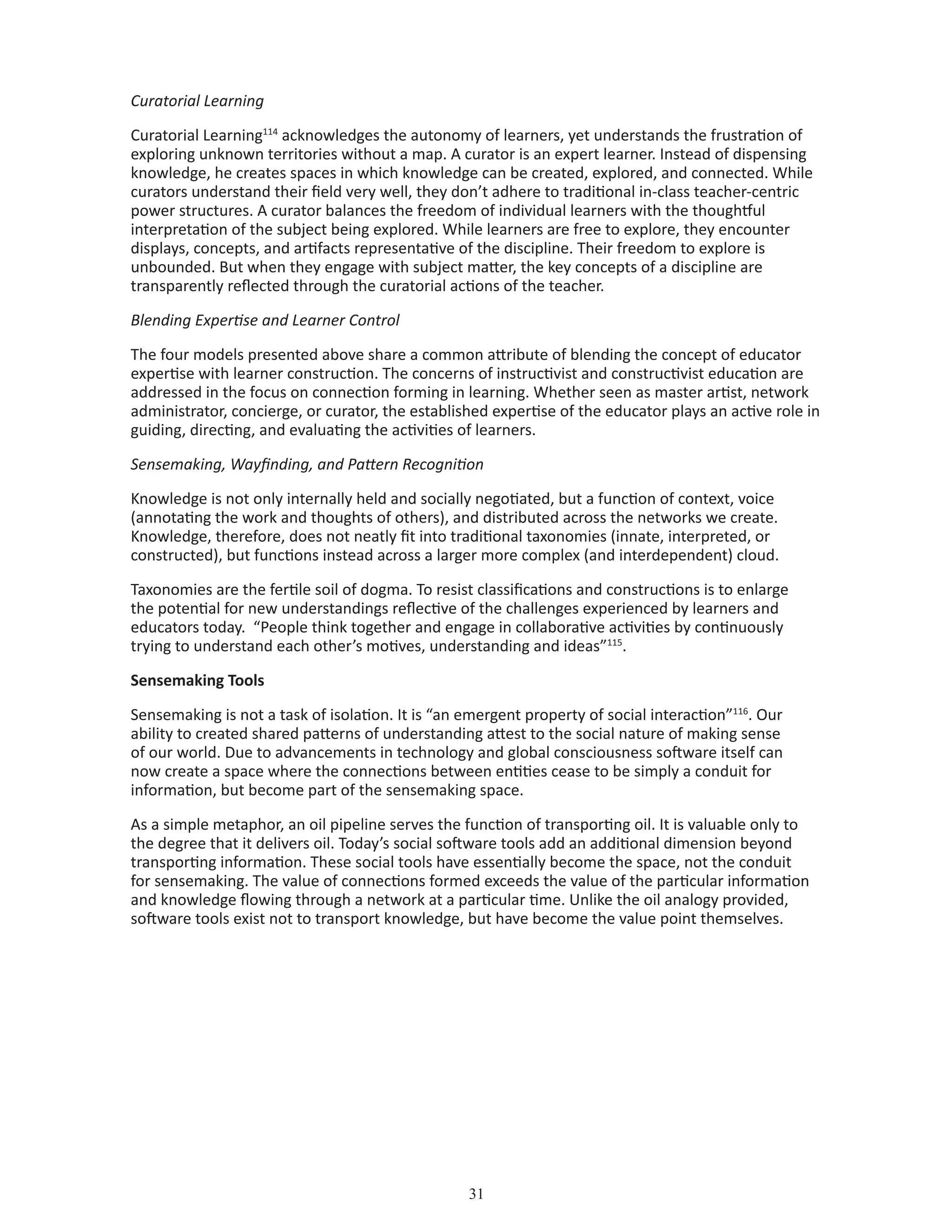
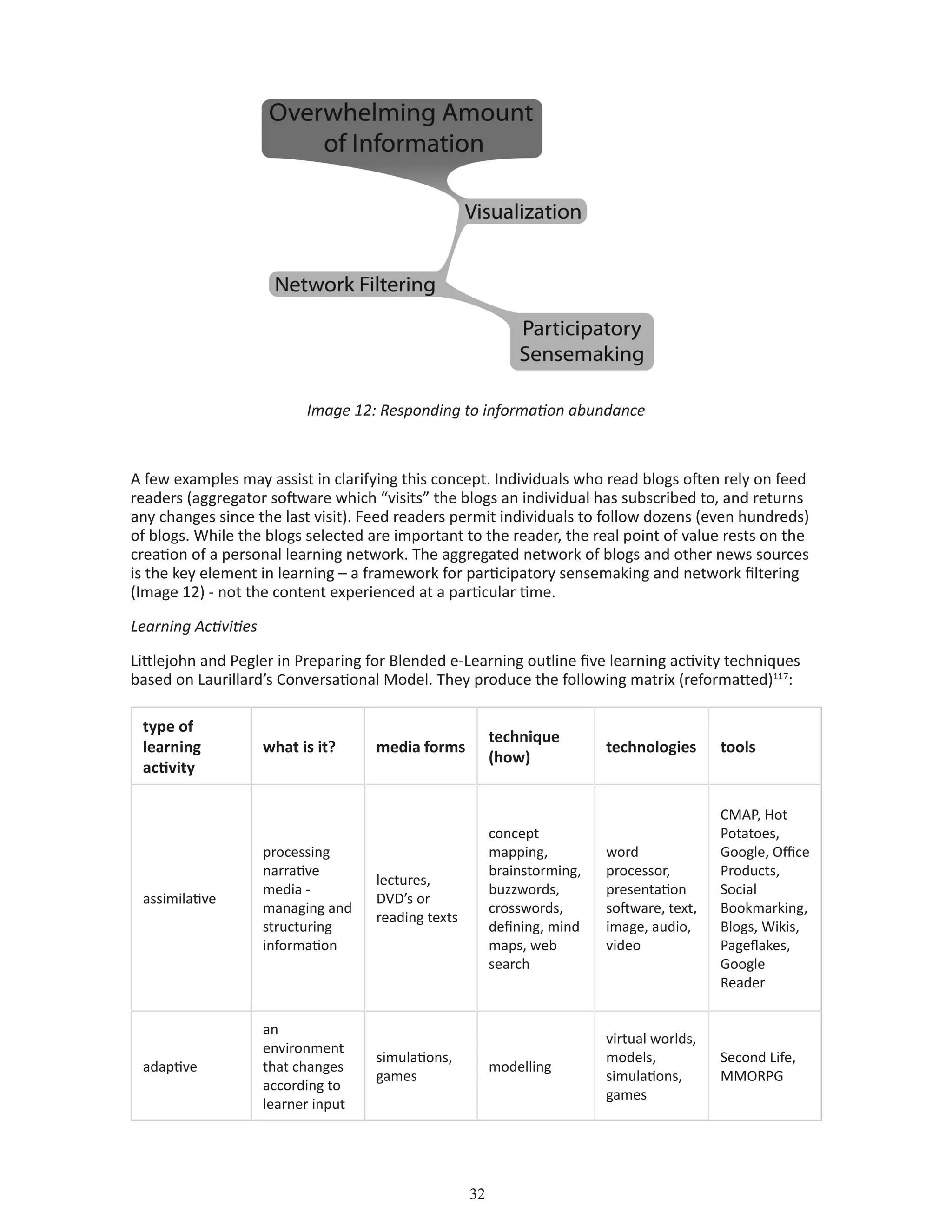
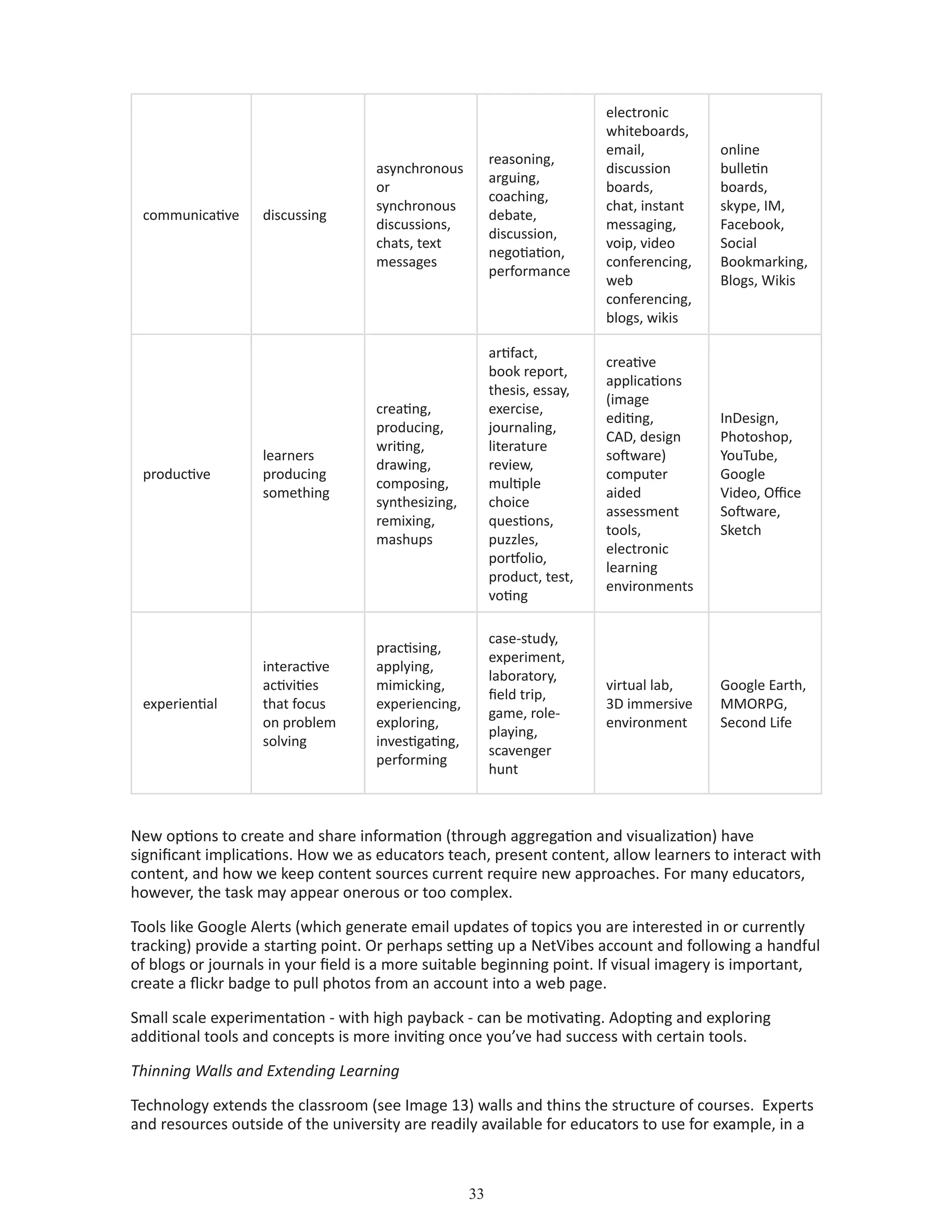
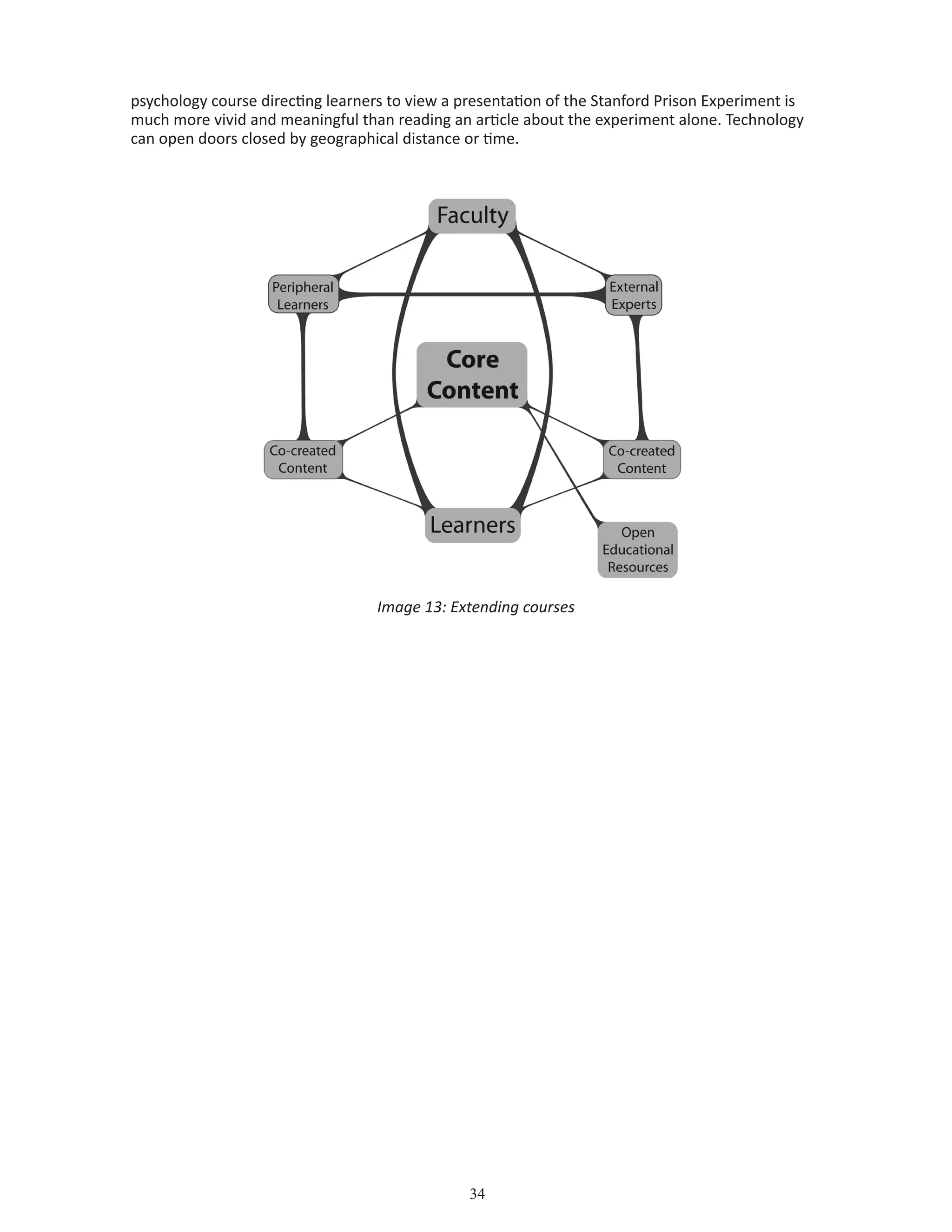
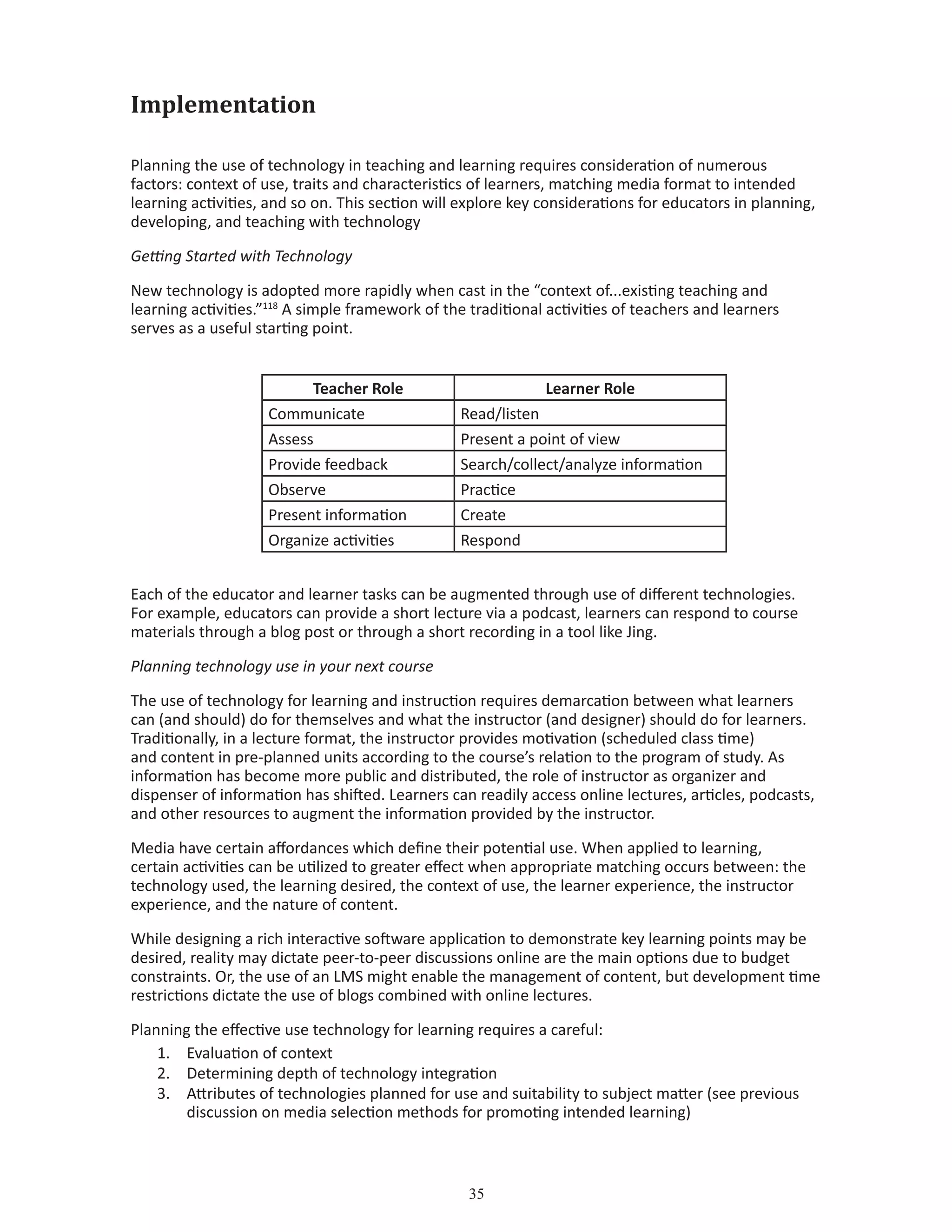
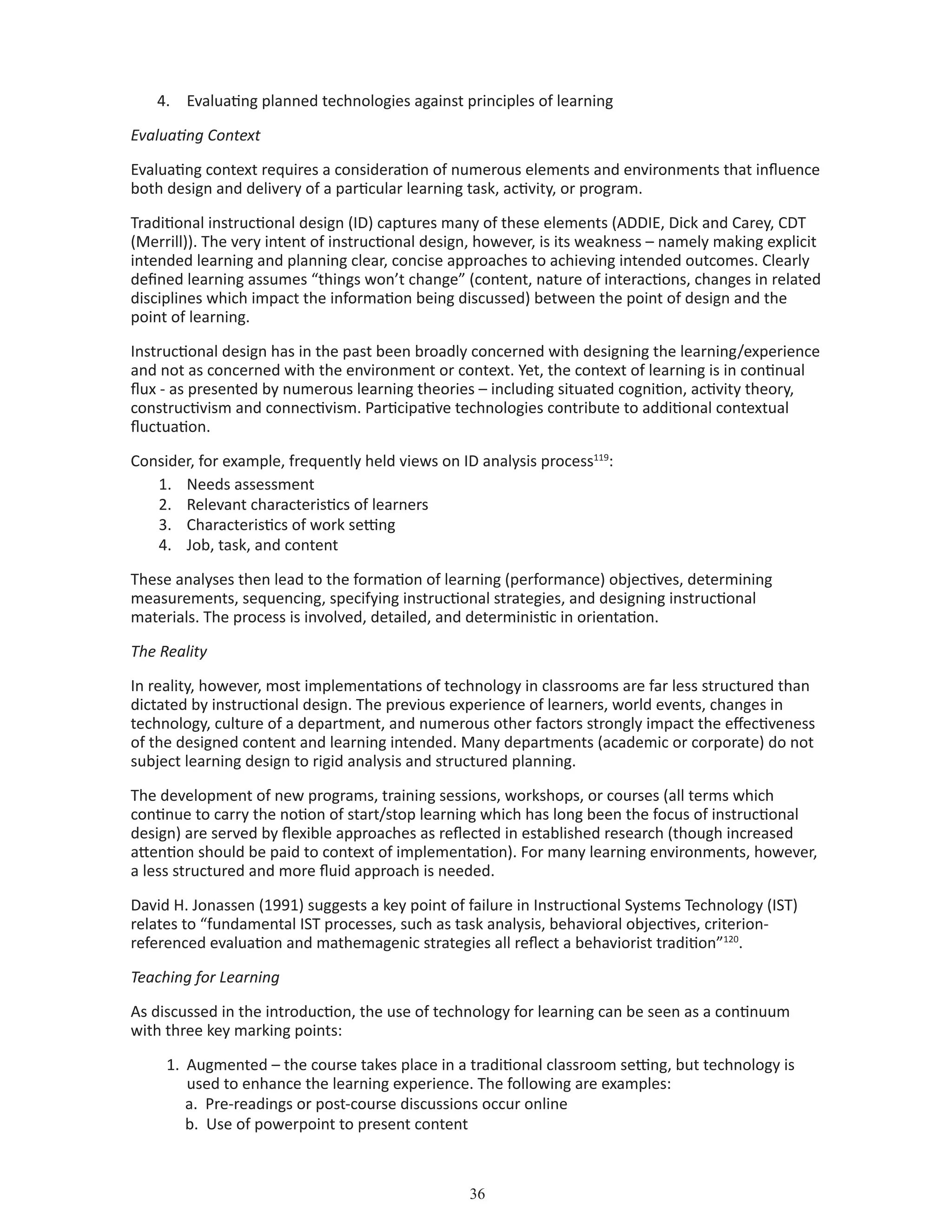

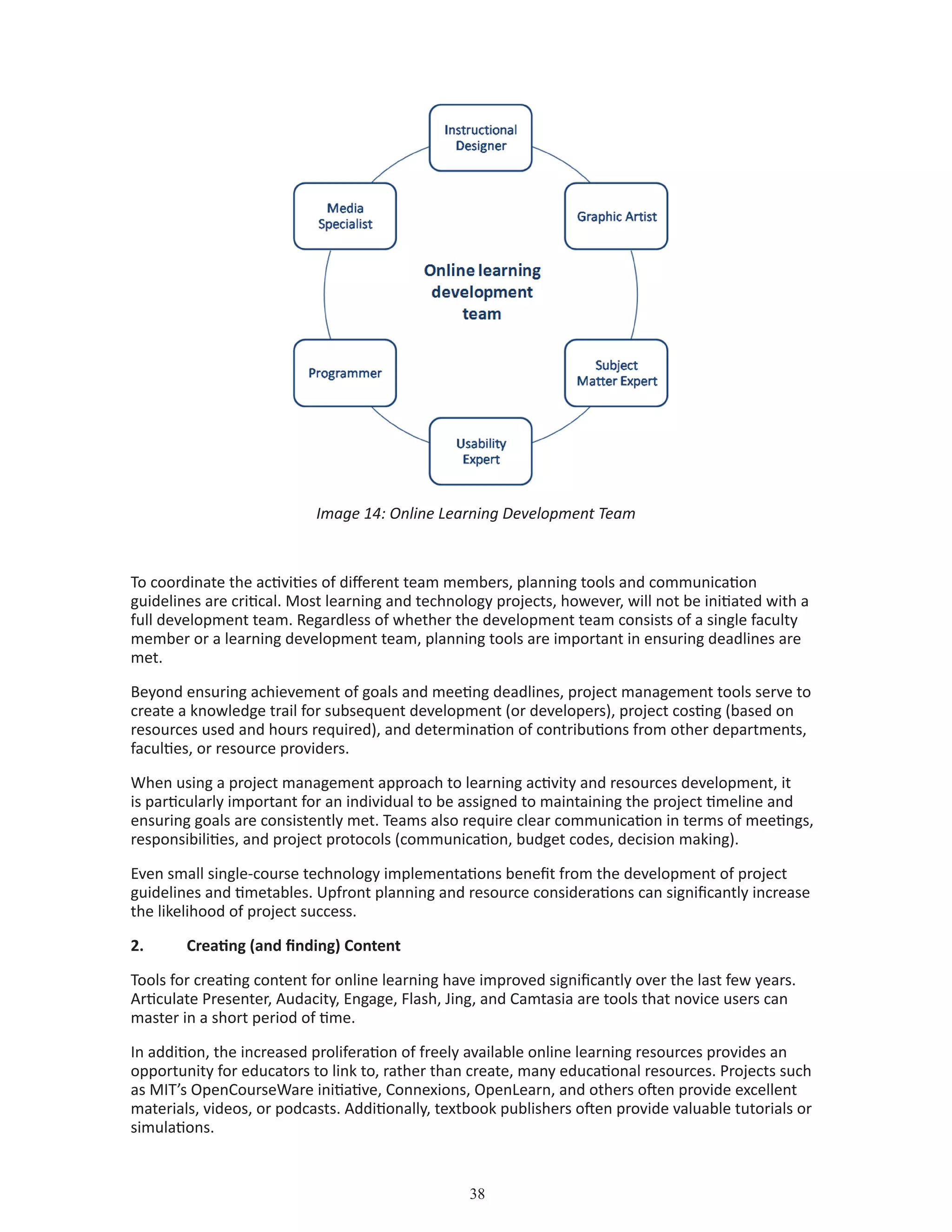
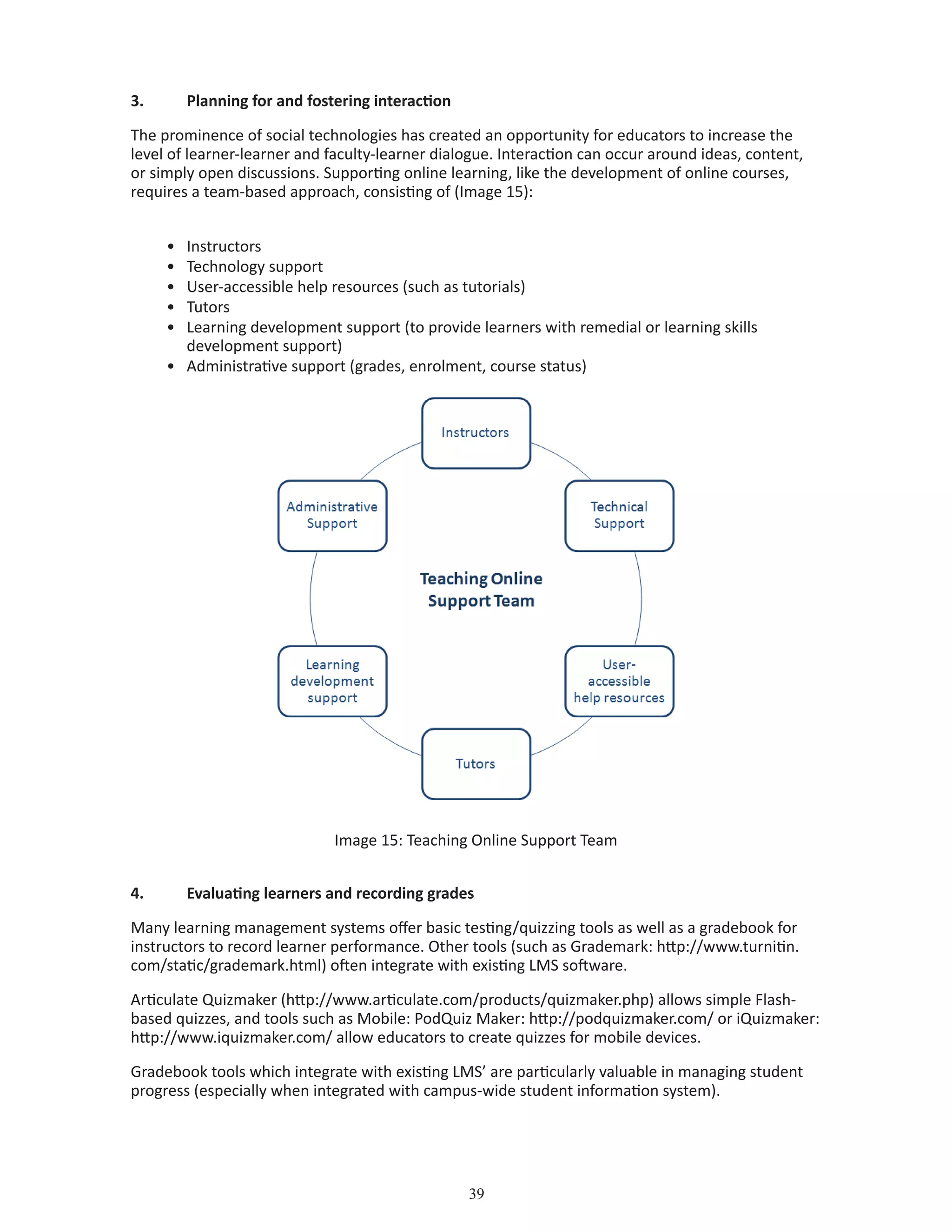
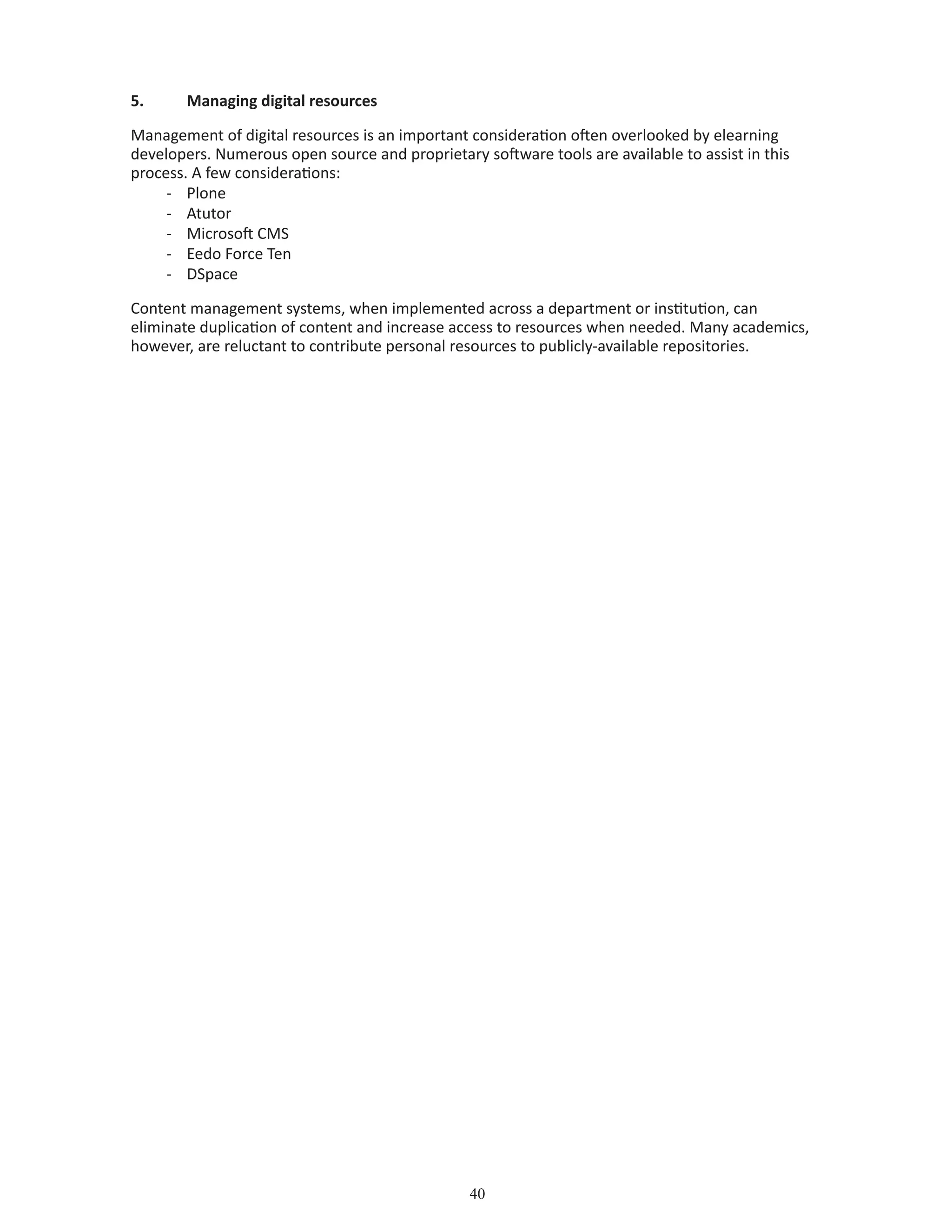

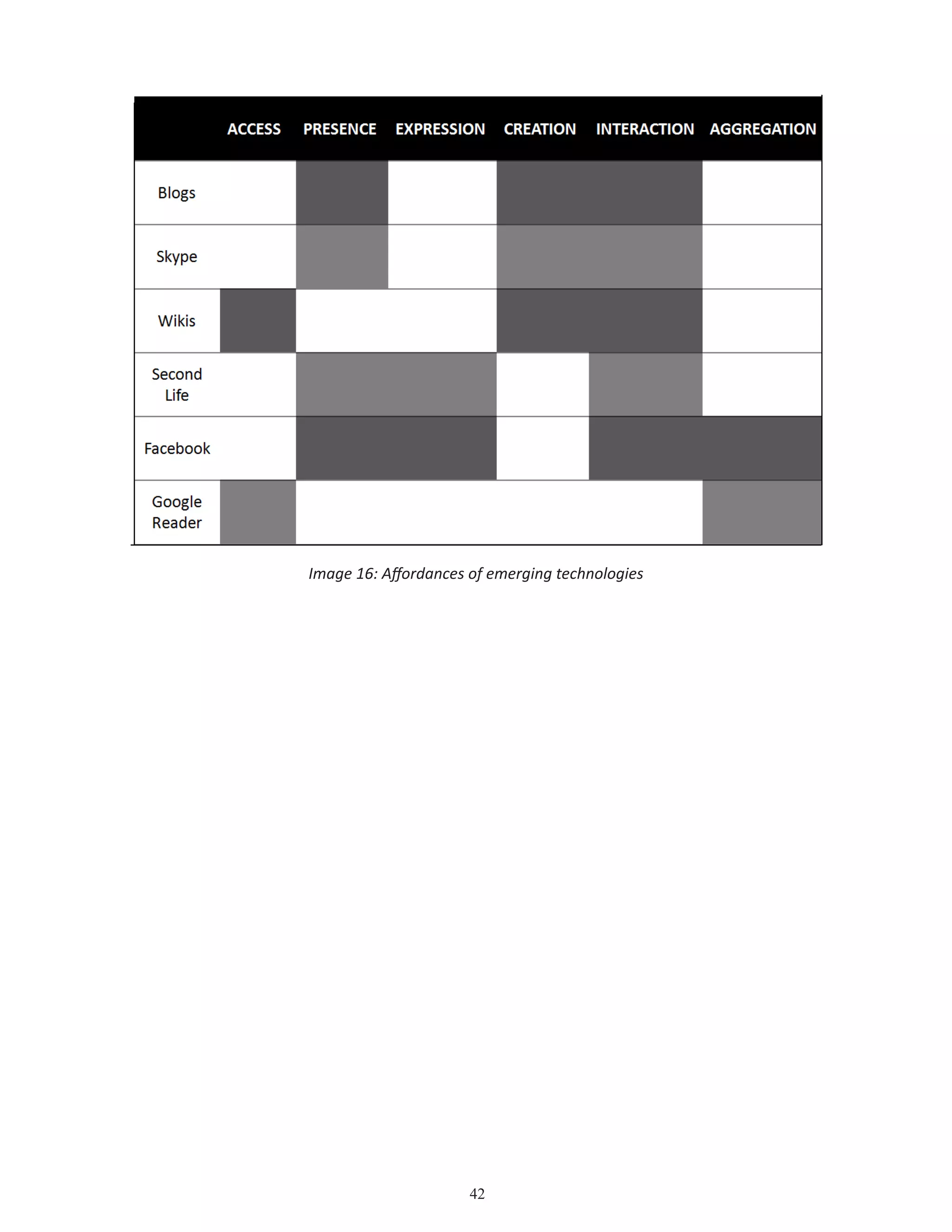
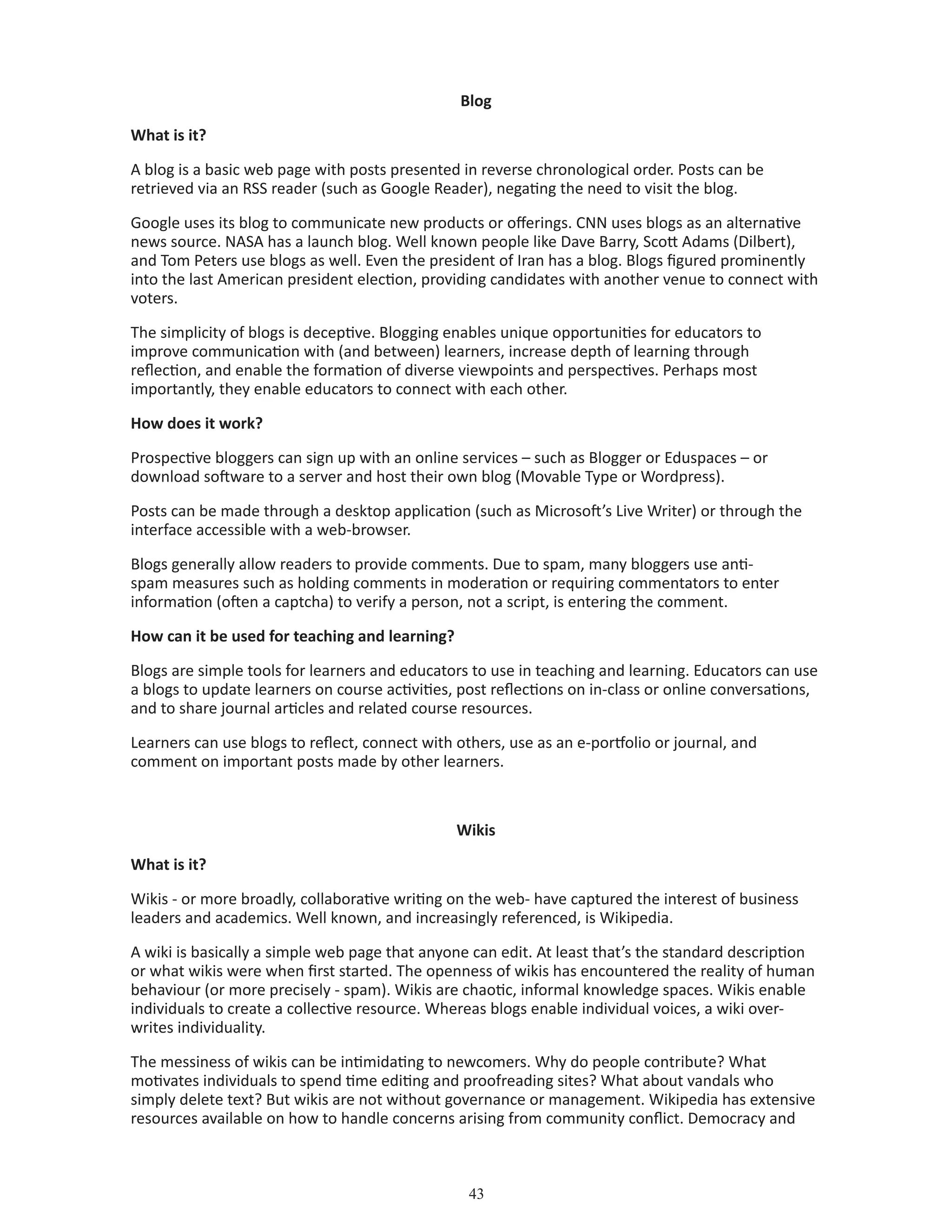

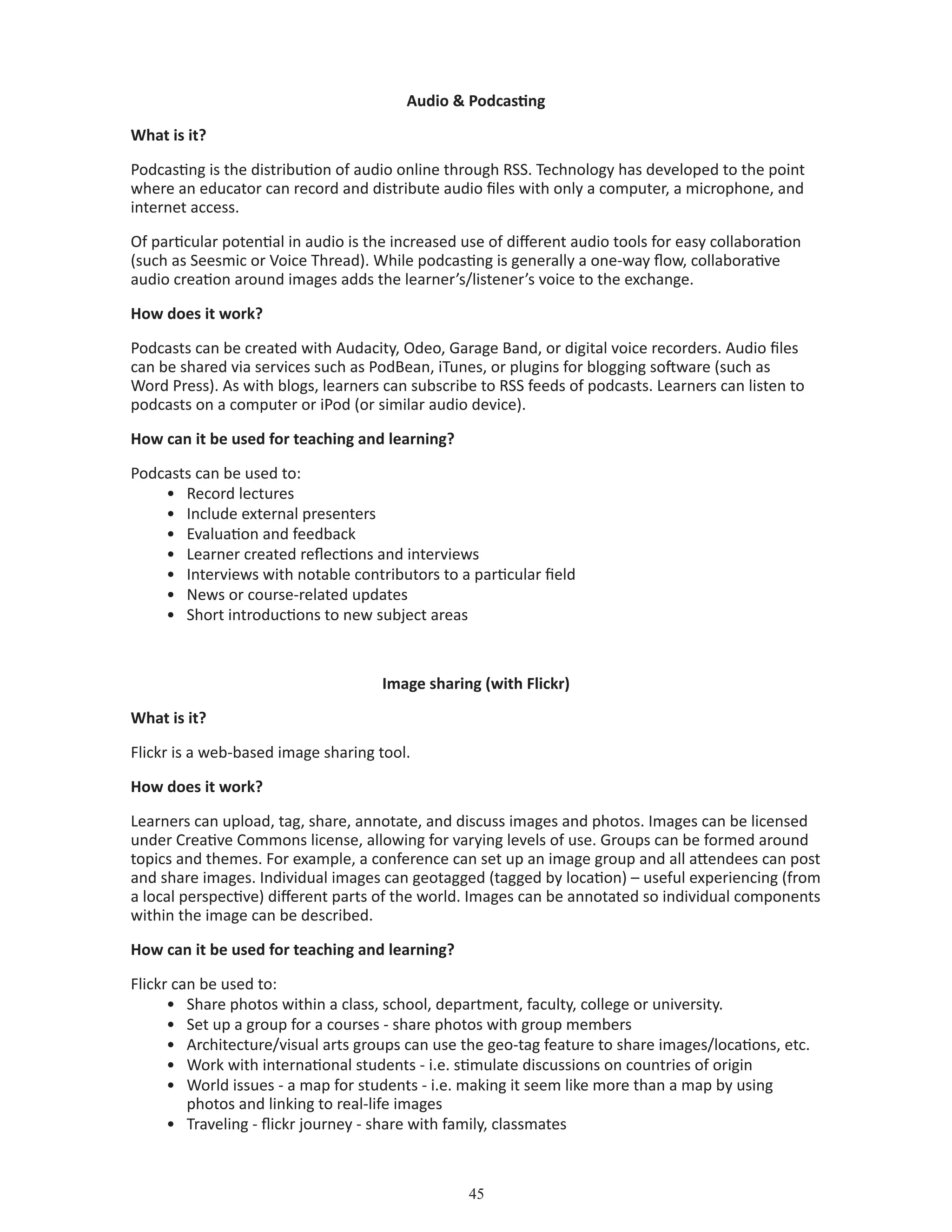
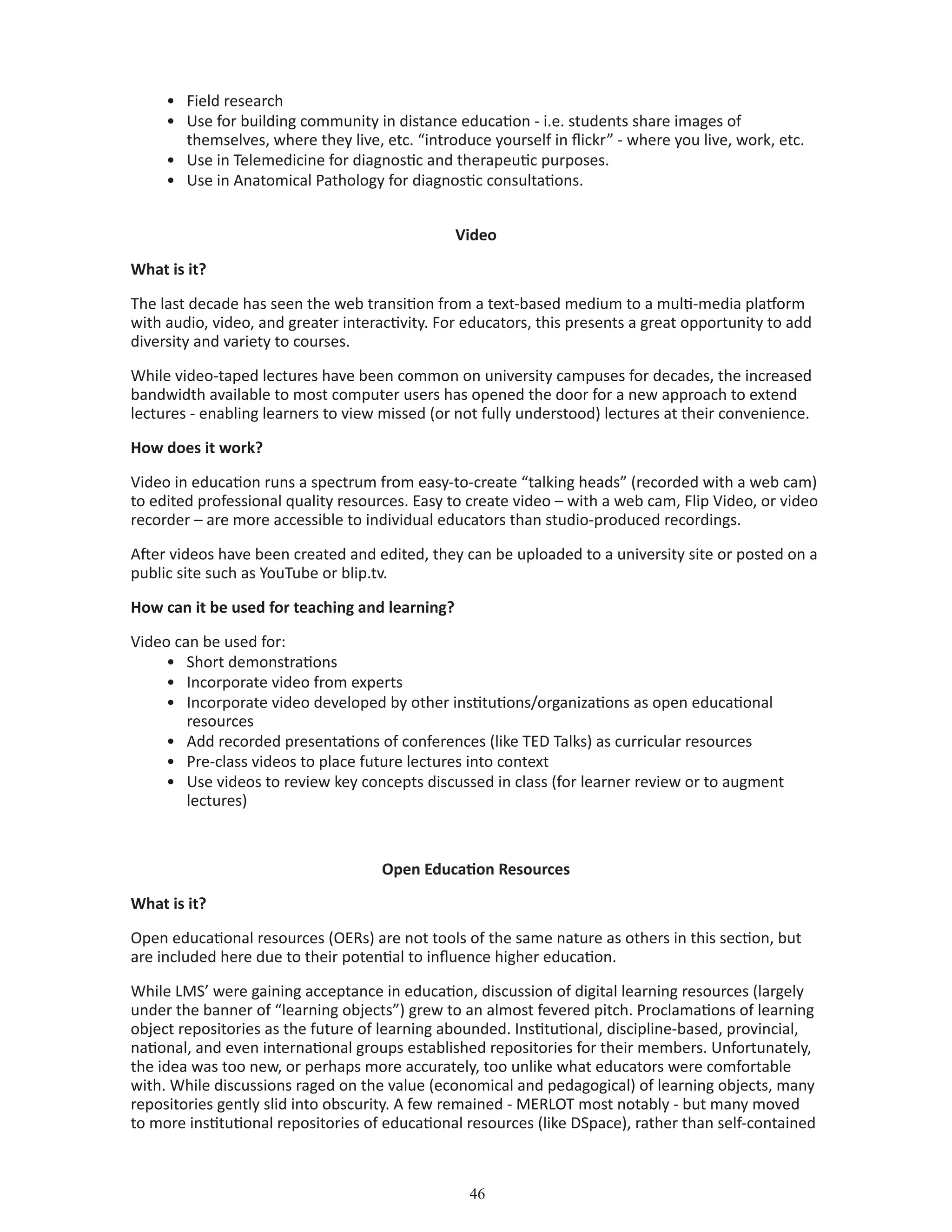
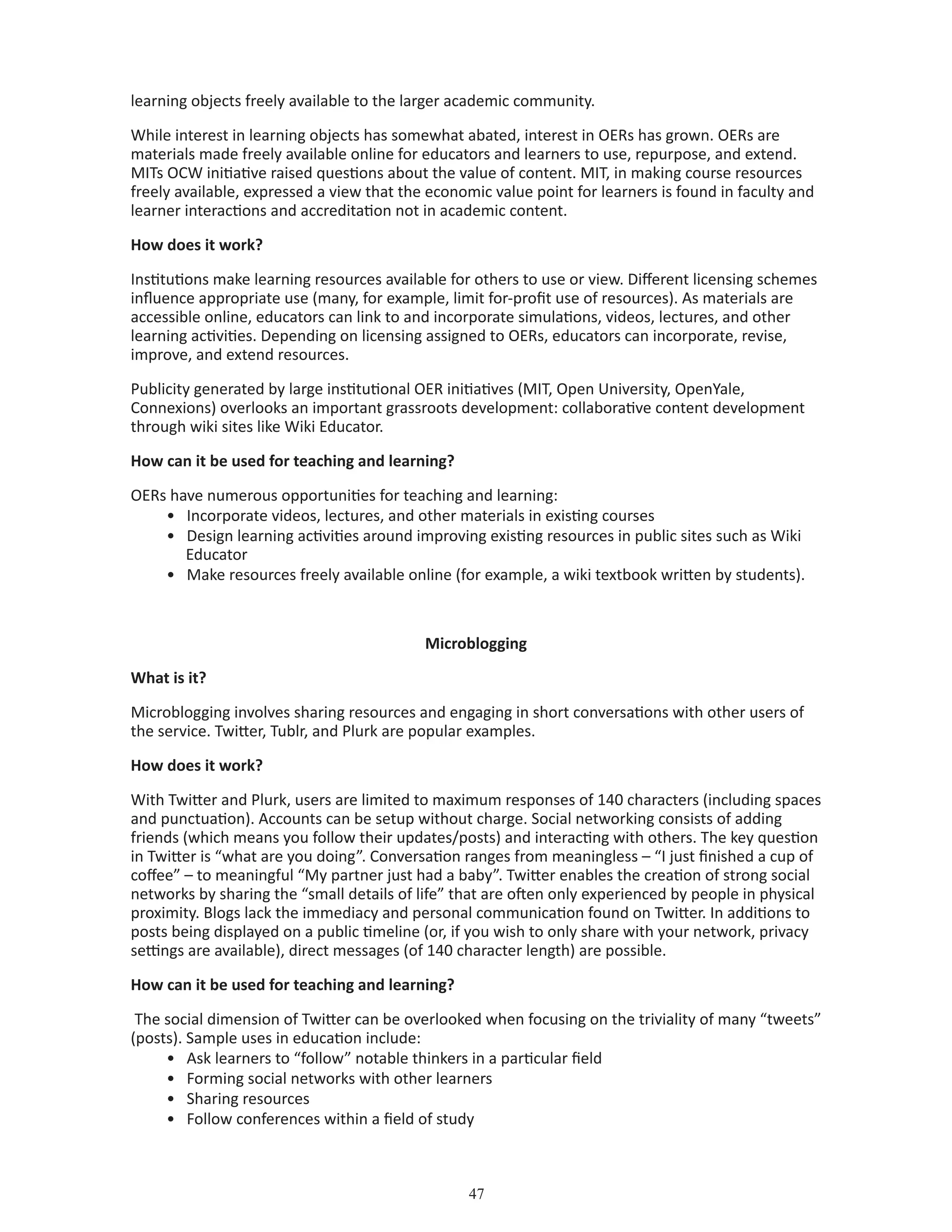
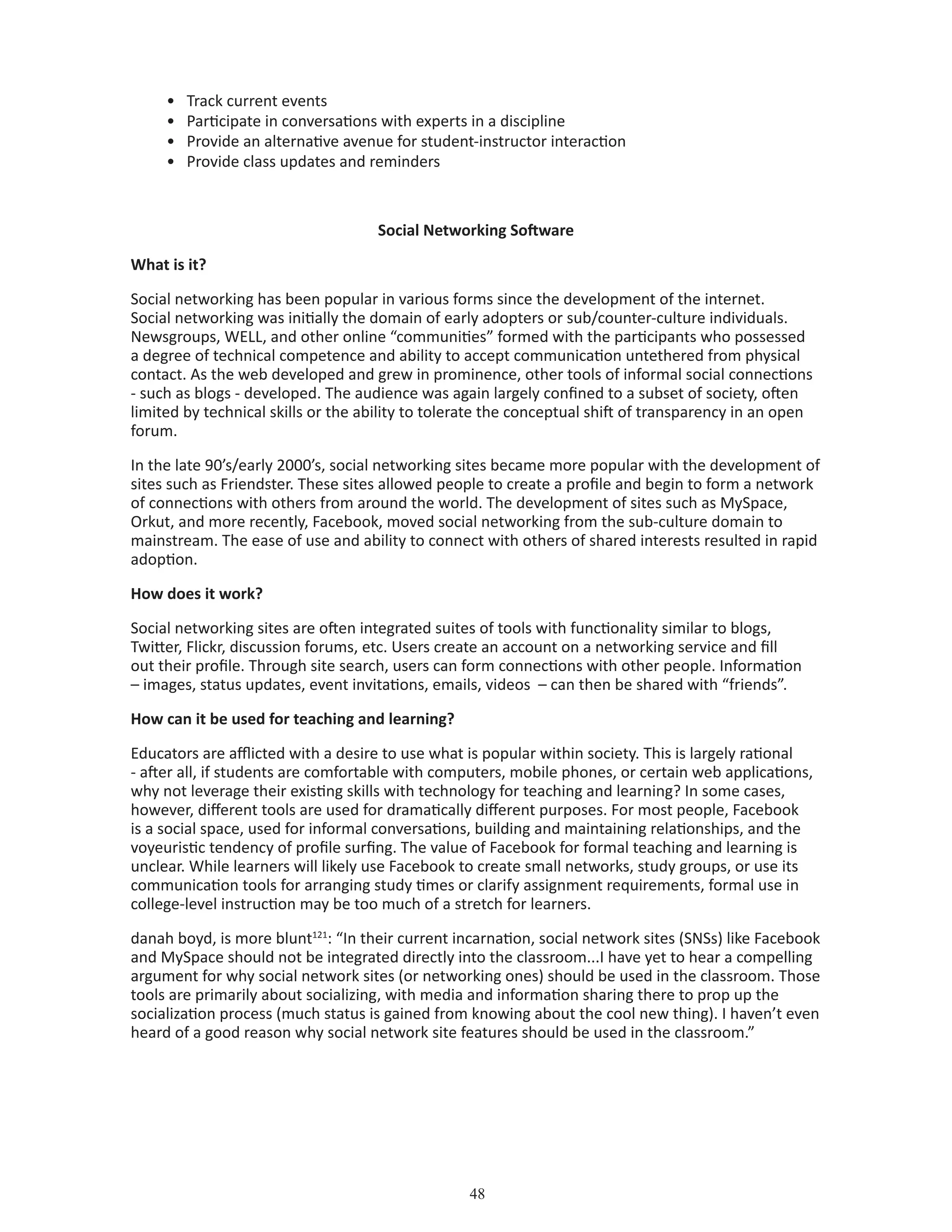
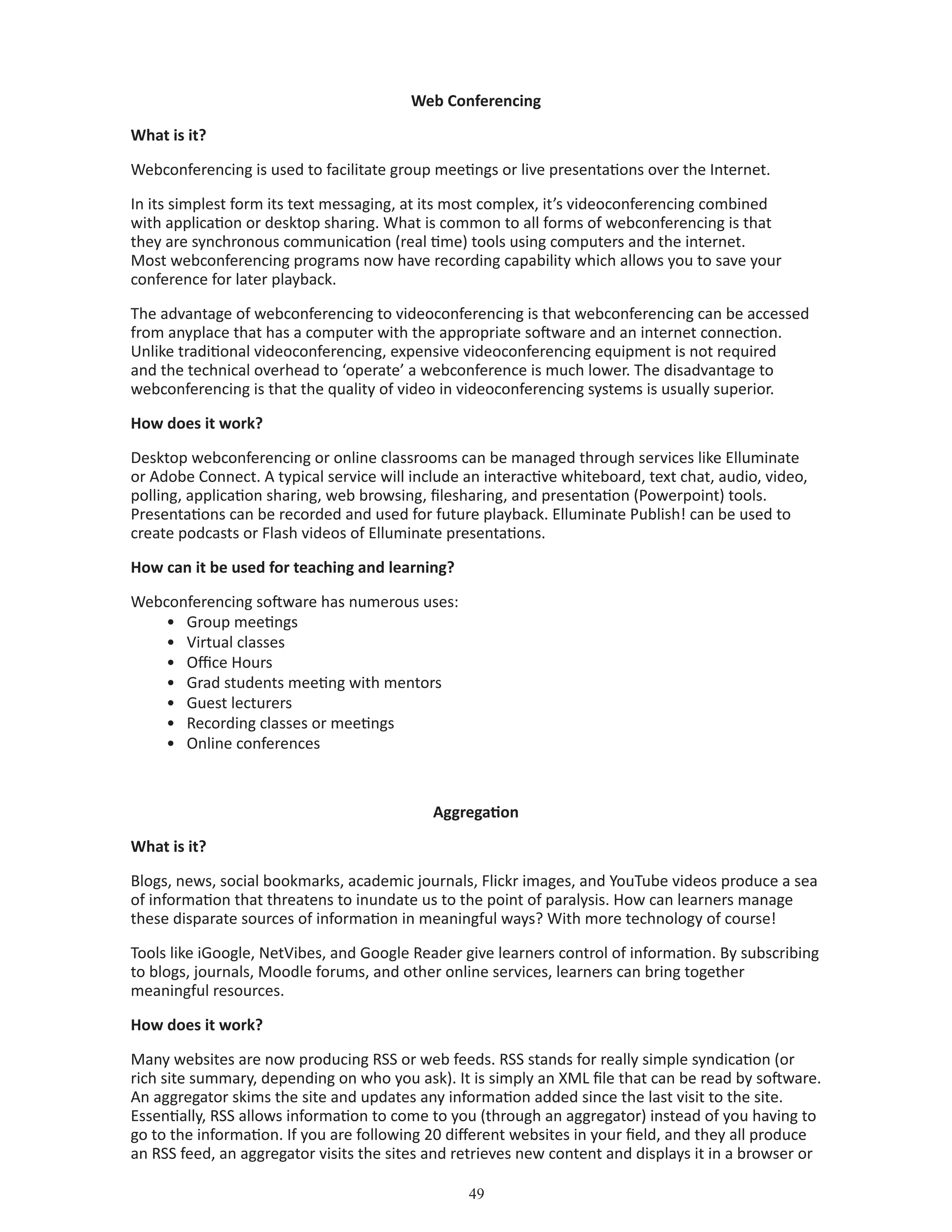
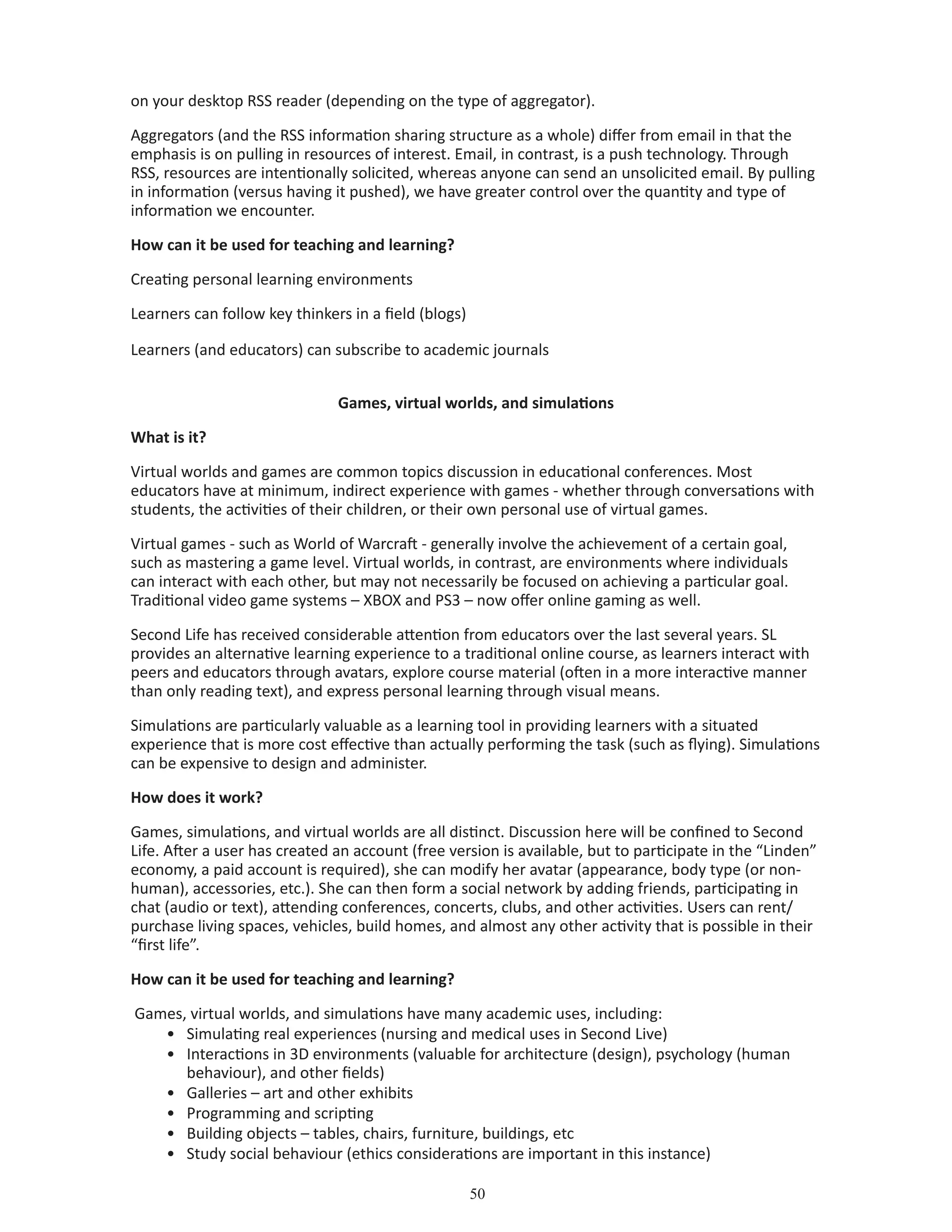
![51
Research
Evaluating the effectiveness of technology use in teaching and learning brings to mind Albert
Einstein’s statement: “Not everything that can be counted counts, and not everything that counts
can be counted”. When we begin to consider the impact and effectiveness of technology in the
teaching and learning process, obvious questions arise: “How do we measure effectiveness? Is it
time spent in a classroom? Is it a function of test scores? Is it about learning? Or understanding?”
Much research has been conducted on how modalities, distance, and models of education
influence the quality of learning. This research is commonly cited as the no significant difference
phenomenon. Joy and Garcia argue that the research is fundamentally flawed - the emphasis on
technology and media is misplaced.
Instead:
[P]ractitioners should adhere to their time-tested instructional design strategies, regardless
of the medium they choose. It is widely accepted that learning effectiveness is a function
of effective pedagogical practices. Accordingly, the question for researchers, instructional
designers, and consumers of ALNs ought to be: “What combination of instructional strategies
and delivery media will best produce the desired learning outcome for the intended
audience?”122
Carol Twigg, suggests education technique is lagging behind technological development123
. As
McLuhan has stated, we use new tools to do the work of the old. The challenge with this often
repeated assertion - namely that we are on the precipice of a complete shift in our framework
of education - is that research, by its nature, is not necessarily concerned with trends. Research
is intended to describe phenomenon occurring now and ways to unearth or discover important
principles on which we can base subsequent action and research.
It is clear that teaching and research in fields of educational technology have yet to achieve
required balance. Arthur Levine provides perhaps the most comprehensive analysis in recent
memory in his systemic exploration of the research failings of education in general124
.
Randolph125
views learning and technology research across a full spectrum of resources and
approaches, indicating the need for educational technology researchers to broaden their view of
research as well as improving the quality of activities within the field. Numerous other researchers
and organizations have emphasized the concerns of research on the use of technology in
education. Terry Anderson has similarly called for a significant shift in the research methodology of
technology-enabled learning, focusing on design-based models126
. He details the need for quality,
relevant research:
“An essential component of effective strategic change is an active research and development
component of the system designed to insure that pedagogical, technological, sociological,
political and commercial changes and opportunities are both developed and exploited within
that system. These insights from effective research and development, originate both from
within education domains as well as being imported from related disciplines”127
.
Design-based research (DBR) has been suggested as a solution to the difficulties facing research
quality, relevance, and impact. DBR is particularly appropriate for exploring emerging educational
technologies because128
:
1. It focuses on interventions in real contexts
2. it involves partnerships between practitioners, students and researchers
3. It is iterative as context and technology changes
4. It is emergent as insights are gathered and developed into principles and patterns.
Distinctions between traditional (predictive) research and DBR are detailed in Image 17.](https://image.slidesharecdn.com/178936784-handbook-of-emerging-technologies-for-learning-150926161322-lva1-app6892/75/Siemens-handbook-of-emerging-technologies-for-learning-55-2048.jpg)
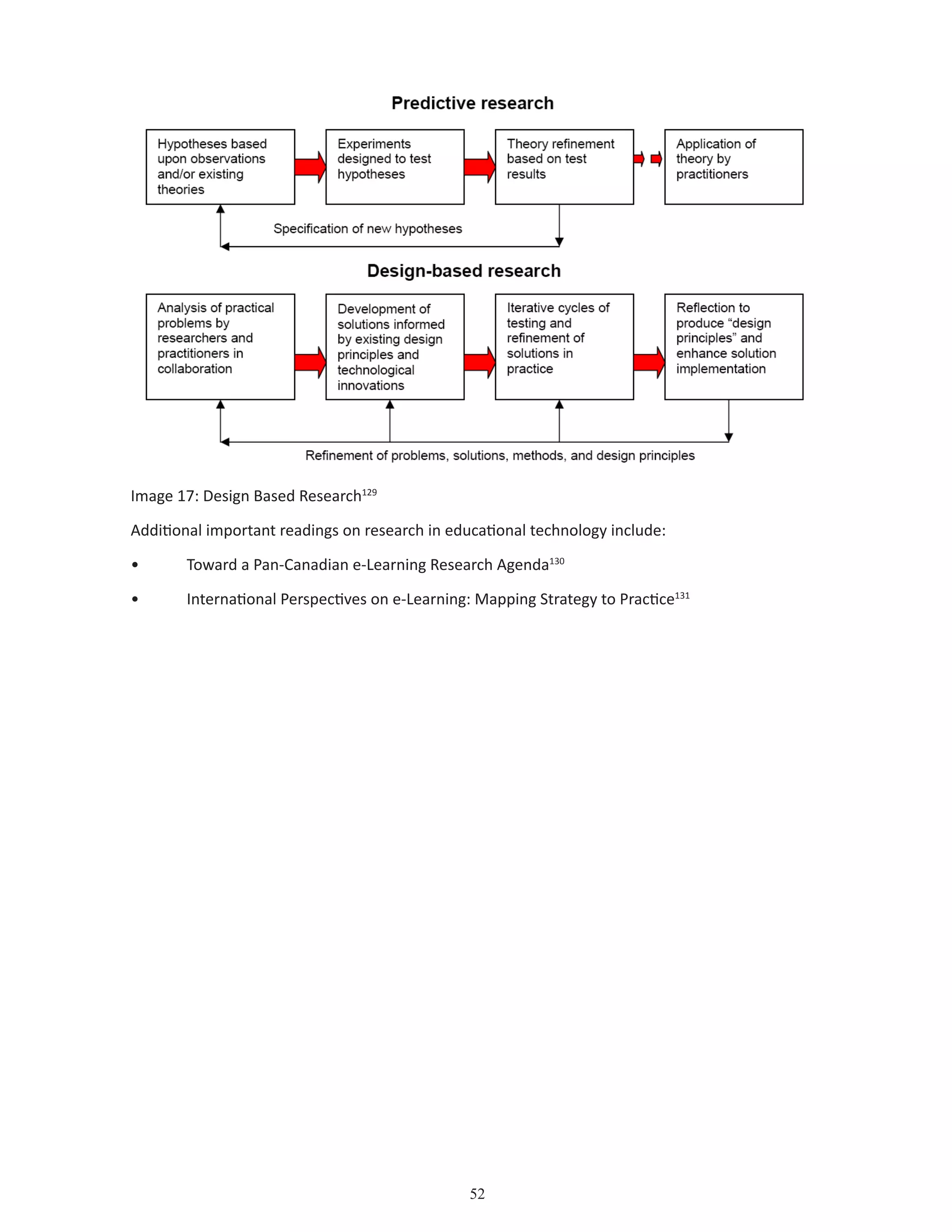


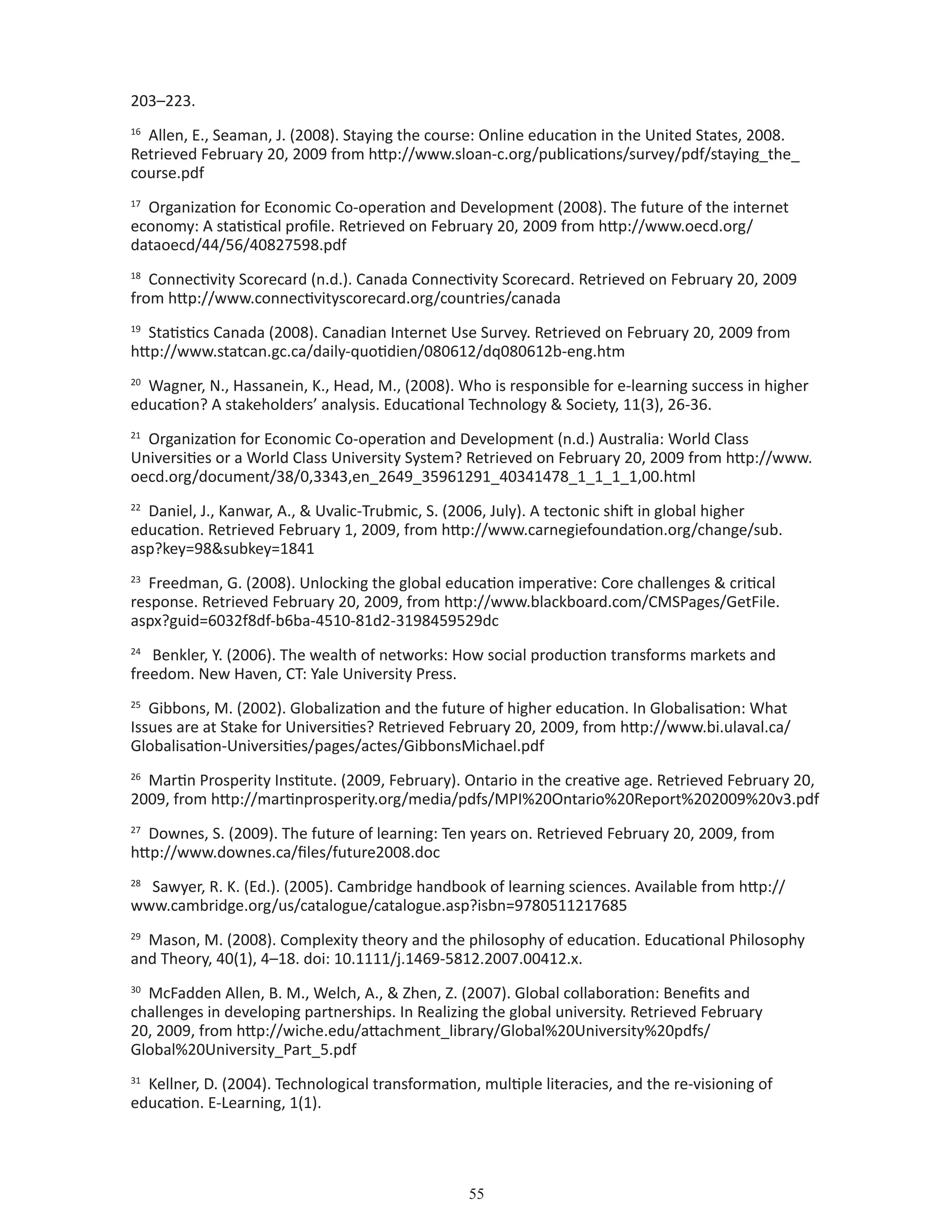
![56
32
Etzkowitz, H., Webster, A., Gebhardt, C., Terra, B. R. C. (2000). The future of the university and
the university of the future: Evolution of ivory tower to entrepreneurial paradigm. Research Policy,
29(2), 313–330.
33
Organization for Economic Co-operation and Development. (n.d.b). Four future
scenarios for higher education. Retrieved February 20, 2009 from http://www.oecd.org/
dataoecd/18/36/42241931.pdf
34
White, S. (2007). Critical success factors for e-learning and institutional change—Some
organizational perspectives on campus-wide e-learning. British Journal of Educational Technology,
38(5), 840–850.
35
Canadian Information Centre for International Credentials. (2008). Information on prior learning
assessment and recognition in Canada [Fact Sheet No. 6]. Retrieved February 20, 2009, from http://
www.cicic.ca/412/Prior_Learning_Assessment_and_Recognition_in_Canada_.canada
36
Canadian Council on Learning. (2008). State of learning in Canada: Toward a learning future.
Retrieved August 1, 2008, from http://www.ccl-cca.ca/NR/rdonlyres/6FA0A21C-50D9-481B-A390-
73852B4E6CB6/0/SOLR_08_English_final.pdf
37
Wellman, B. (1999). Networks in the global village: Life in contemporary communities. Boulder,
CO: Westview Press.
38
Barabási, A. L. (2002). Linked: The new science of networks. Cambridge, MA: Perseus Publishing.
39
Watts, D. J. (2003). Six degrees: The science of a connected age. New York: W.W. Norton.
40
Castells, M. (1996). The rise of the network society. Malden, MA: Blackwell.
41
Benkler, Y. (2006). The wealth of networks: How social production transforms markets and
freedom. New Haven, CT: Yale University Press.
42
Gantz, J.F., Reinsel, D., Chute, C., Schlichting, W., McArthur, J., Minton, S., et al. (2007). The
expanding digital universe: A forecast of worldwide information growth through 2010. Framingham,
MA: IDC. Retrieved December 27, 2007, from http://www.emc.com/about/destination/digital_
universe/
43
Feltovich, P. J., Prietula, M. J., Ericsson, K. A. (2006). Studies of expertise from psychological
perspectives. In K. A. Ericsson, N. Charness, P. J. Feltovich, R. R. Hoffman (Eds.), Cambridge
handbook of expertise and expert performance (Paperback, pp. 41–67). London: Cambridge
University Press.
44
Barnett, R. (2004). Learning for an unknown future. Higher Education Research Development,
23(3), 247–260. doi: 10.1080/0729436042000235382
45
Harvard University. (2007). Report of the task force on general education. Retrieved February 20,
2009, from http://www.fas.harvard.edu/~secfas/General_Education_Final_Report.pdf
46
Image adapted from: Fischer, G., Konomi, S. (2007). Innovative socio-technical environments
in support of distributed intelligence and lifelong learning. Journal of Computer Assisted Learning,
23(4), 338–350.
47
Sawyer, R. K. (Ed.). (2005). The new science of learning. In The Cambridge handbook
of learning sciences. Available from http://www.cambridge.org/us/catalogue/catalogue.
asp?isbn=9780511217685
48
Wenger, E. (1998). Communities of practice: Learning, meaning, and identity. New York:
Cambridge University Press.](https://image.slidesharecdn.com/178936784-handbook-of-emerging-technologies-for-learning-150926161322-lva1-app6892/75/Siemens-handbook-of-emerging-technologies-for-learning-60-2048.jpg)
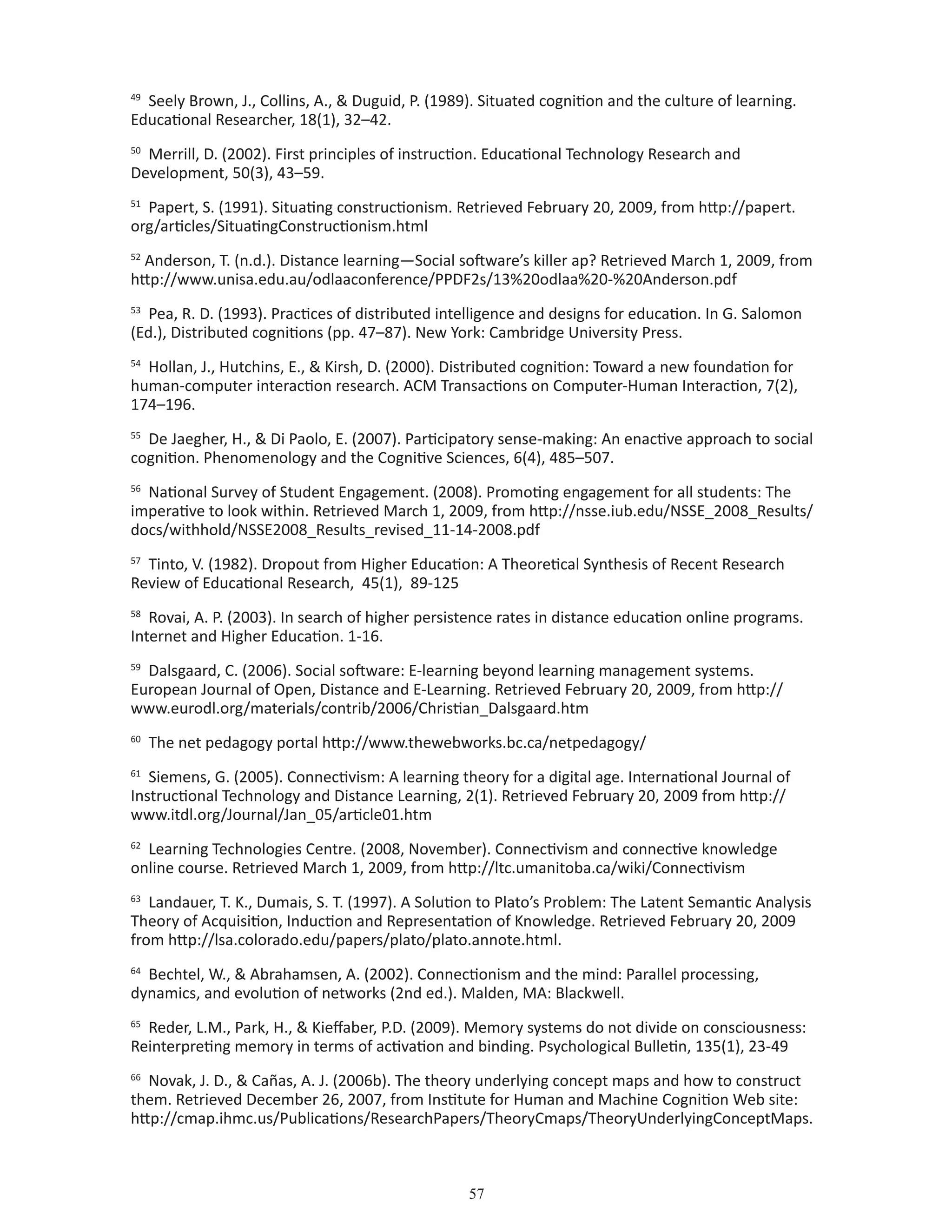

![59
Educational Media International, 45(1), 1–15.
84
Tessmer, M., Richey, R. C. (1997). The role of context in learning and instructional design.
Educational Technology Research and Development, 44(2), 85–115.
85
Mitchell, B., Geva-May, I. (2009). Attitudes affecting online learning implementation in higher
education institutions. Journal of Distance Education, 23(1), 71-88.
86
Osberg, D., Biesta, G. (2008). The emergent curriculum: Navigating a complex course between
unguided learning and planned enculturation. Journal of Curriculum Studies, 40(3), 313–328. doi:
10.1080/00220270701610746.
87
Clark, R. E. (1983). Reconsidering Research on Learning from Media. Review of Educational
Research (53)4, 445-459.
88
Kozma, R. B. (1991). Learning with Media. Review of Educational Research. 61(9). 179-211.
89
Fadel, C., Lemke, C. (2008). Multimodal learning through media: What the research says.
Retrieved February 20, 2009, from http://www.cisco.com/web/strategy/docs/education/
Multimodal-Learning-Through-Media.pdf
90
Greeno, J. G. (1994). Gibson’s Affordances. Psychological Review. 101(2), 336-342
91
Dron, J. (2007). Designing the undesignable: Social software and control. Educational Technology
and Society, 10(3), 60–71
92
McLaughlin, A. C., Rogers, W. A., Sierra, Jr., E. A., Fisk, A. D. (2007). The effects of instructional
media. Identifying the task demand/media match. Learning, Media, and Technology, 32(4), 381–
405.
93
Moore, A. H. (2007). The new economy, technology, and learning outcomes assessment.
EDUCAUSE. Retrieved on February 20, 2009 from http://connect.educause.edu/Library/
EDUCAUSE+Quarterly/TheNewEconomyTechnologyan/44829?time=1235939355
94
National Survey of Student Engagement (NSSE). (2007). Experiences that matter: Enhancing
student learning and success. Bloomington, IN: Author. Retrieved December 27, 2007, from http://
nsse.iub.edu/NSSE%5F2007%5FAnnual%5FReport/docs/withhold/NSSE_2007_Annual_Report.pdf
95
EDUCAUSE Center for Applied Research [ECAR]. (2007). The ECAR study of undergraduate
students and information technology. Retrieved December 27, 2007, from http://www.educause.
edu/ir/library/pdf/ers0706/rs/ERS0706w.pdf
96
de Laat, M. (2006). Networked learning. Retrieved December 27, 2007, from http://www.e-
learning.nl/files/dissertatie%20maarten.pdf (p. 174)
97
Bennet, S.. Maton, K., Kervin, L. (2008). The “digital natives” debate: A critical review of the
evidence. British Journal of Educational Technology, 39(5), 775–786.
98
Kennedy, G. E., Judd, T. S., Churward, A., Gray, K., Krause, K (2008). First year students’
experiences with technology: Are they really digital natives? Australasian Journal of Educational
Technology, 24(1), 108–122.
99
Dewey, J. (1997). Experience education. New York: Touchstone.
100
Freire, P. (1970). Pedagogy of the oppressed. London: Continuum.
101
Illich, I. (1970). Deschooling society. London: Marion Boyars.
102
Bandura, A. (2002). Social cognitive theory in cultural context. Applied Psychology: An](https://image.slidesharecdn.com/178936784-handbook-of-emerging-technologies-for-learning-150926161322-lva1-app6892/75/Siemens-handbook-of-emerging-technologies-for-learning-63-2048.jpg)
![60
International Review, 51(2), 269–290.
103
Lankshear, C., Knoble, M. (2003) Digital Literacies: Policy, Pedagogy and Research Considerations
for Education. Retrieved on February 20, 2009 from: http://www.geocities.com/c.lankshear/Oslo.
pdf
104
Siemens, G. (2006). Knowing knowledge. Vancouver, BC, Canada: Lulu Press.
105
Kirschner, P., Sweller, J., Clark, R. (2006). Why minimal guidance during instruction does
not work: An analysis of the failure of constructivist, discovery, problem-based, experiential, and
inquiry-based teaching. Educational Psychologist 41(2), 75-86.
106
Gardner, H. (2006). Five minds for the future. Boston: Harvard Business School Press. (p. 28)
107
Mitra, S. (2007, June). Technology and higher education — Pedagogy for self organised learning
systems. Paper presented at Future of Education Online Conference. Retrieved on December
28, 2007, from https://sas.elluminate.com/site/external/jwsdetect/playback.jnlp?psid=2007-06-
04.0738.M.BB2E854755AAFFF4E1A3E2523C4E54.vcr
108
Darken, R., Sibert, J. (1996). Wayfinding strategies and behaviors in large virtual worlds.
Retrieved December 27, 2007, from http://sigchi.org/chi96/proceedings/papers/Darken/Rpd_txt.
htm
109
Wilson, S. (2008). Patterns of personal learning environments. Interactive Learning
Environments. 16(1). 17-34.
110
Egan, K. (2002). Getting it wrong from the beginning: Our progressivist inheritance from Herbert
Spencer, John Dewey, and Jean Piaget. New Haven, CT: Yale University Press. P. 38
111
Brown, J. S. (2006, March). Learning in the digital age (21st century). Paper [keynote] presented
at the Ohio Digital Commons for Education (ODCE) 2006 Conference. Retrieved December 27, 2007,
from http://www.oln.org/conferences/ODCE2006/papers/jsb-2006ODCE.pdf
112
Fisher, C. (n.d.). Teacher as Network Administrator. Retrieved December 27, 2007, from http://
remoteaccess.typepad.com/remote_access/files/teacher_as_network_admin.pdf
113
Bonk, C. (2007). USA Today Leads to Tomorrow: Teachers as online concierges and can Facebook
pioneer save face? Retrieved on December 27, 2007 from http://travelinedman.blogspot.
com/2007/10/usa-today-leads-to-tomorrow-teachers-as.html.
114
Siemens, G. (2007). 10 minute lecture – curatorial teaching. Retrieved on February 20, 2009
from http://learnonline.wordpress.com/2007/09/20/10-minute-lecture-george-siemens-curatorial-
teaching/
115
Arnseth, H. C., Solheim, I. (2003). Making Sense of Shared Knowledge. Proceedings of:
Computer Support for Collaborative Learning 2002 meeting in Boulder, Colorado, January 7-11,
2002
116
Furberg, A., Arnseth, H. C. (2009). Reconsidering conceptual change from a socio-cultural
perspective: analyzing students’ meaning making in genetics in collaborative learning activities.
Cultural Studies of Science Education. 4(1), 157-191.
117
Littlejohn, A., Pegler, C. (2007). Preparing for blended e-learning. Routledge, LONDON: UK
118
McGee, P., Diaz, V. (2007) Wikis and Podcasts and Blogs! Oh My! What’s a faculty member to
do? EDUCAUSE. Retrieved on Feruary 20, 2009 from http://www.educause.edu/apps/er/erm07/
erm0751.asp](https://image.slidesharecdn.com/178936784-handbook-of-emerging-technologies-for-learning-150926161322-lva1-app6892/75/Siemens-handbook-of-emerging-technologies-for-learning-64-2048.jpg)
